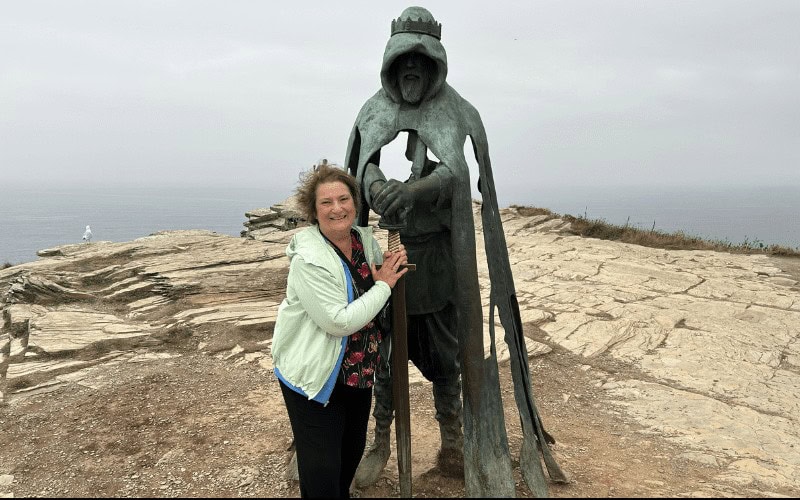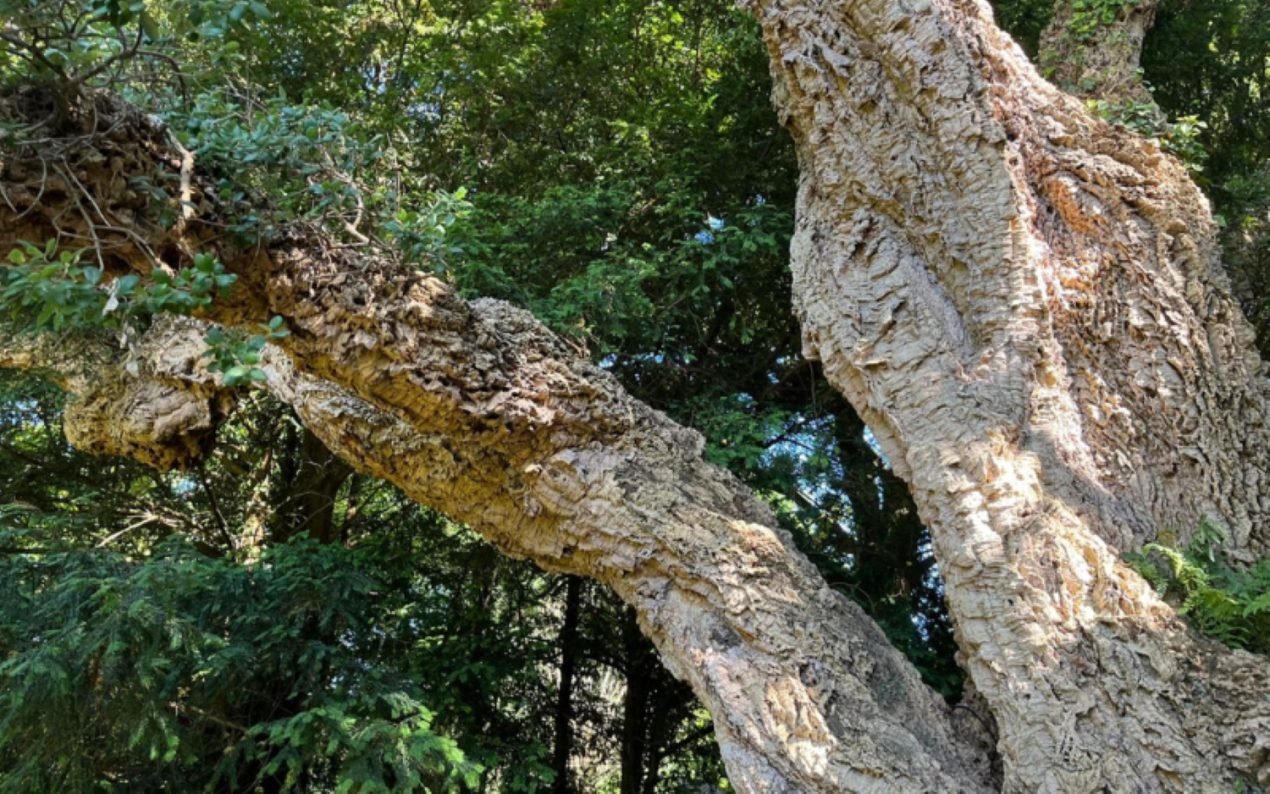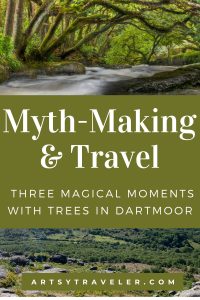Get the Best Out of Southwest England on a Rabbie’s Small Group Tour
Consider taking a Rabbie’s small group tour of Southwest England to discover one of England’s most beautiful (and visited) regions.
When I travel on my own, I often take small group tours so I can efficiently explore local sites. Usually, I opt for day tours (see my posts about tours in the Cotswolds and Yorkshire).
But on a recent, longer trip to the UK, I chose a four-day, three-night small group tour of Devon and Cornwall with Rabbie’s Tours.
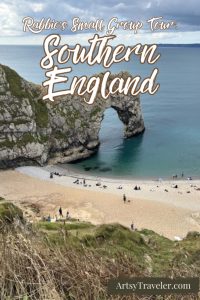
Based in Edinburgh, Scotland, Rabbie’s operates dozens of tours throughout the United Kingdom and Europe. Their reviews are excellent and the prices reasonable. I figured I couldn’t lose—and I was right. In this post, I present a day-by-day account of what I experienced on my four-day, three-night Rabbie’s small group tour, starting in Bristol.
Spoiler Alert: I cheerfully recommend a Rabbie’s small group tour, particularly if your time is limited.
Map of Southwest England: Locations Visited
The map of Southwest England below shows the locations I visited. I stayed in Falmouth (#5) for two nights and Exeter (#23) for one night. Click a number to read more about the location.
Setting Off on a Rabbie’s Small Group Tour of Southwest England
Bright and early at 8:00 am on September 1, I’m out front of the Doubletree Hilton Hotel in Bristol (#22 on the map), where I meet the first two people I’ll be touring with, a couple from Virginia in the US.
They tell me this will be their fourth Rabbie’s small group tour. This bodes well since they have only positive things to say about the tours they’ve taken to Wales and Scotland.
We board and soon stake out our personal space for the next four days. With the entire 16-seat van at our disposal, we each have our own row. It’s delightful to spread out across two seats with another across the aisle rather than having to share the admittedly narrow seats with a stranger for four days.

Day 1: Somerset to Cornwall on Rabbie’s Small Group Tour of Southwest England
We pull away from the hotel and head out of Bristol. I settle into my seat and listen to Matt when he’s talking and then think when he’s not.
Notebook open and pen at the ready, I alternate between jotting down notes about what we’re seeing and planning two new novels.
Matt reviews our itinerary for the day. We’ll travel west from Bristol along the north coast of Somerset, across Exmoor in Devon and then angle southwest to Falmouth on the south coast of Cornwall—our home base for two of the three nights.
He uses arrow stickies to show our route on the large map of southern England pinned above the front window.
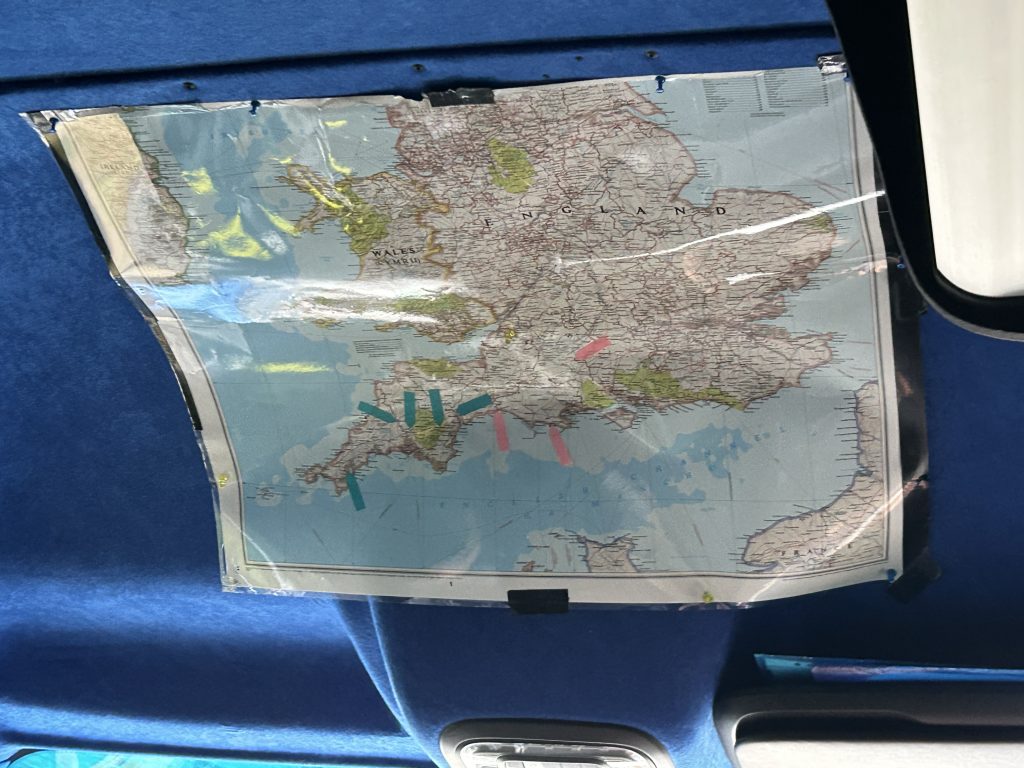
Over the next four days, I’ll enjoy studying the map not only to follow our route but also to remember many of the places I visited when I lived in England back in the 1970s.
First Stop on the Rabbie’s Small Group Tour: Dunster in Somerset
Dunster (#1) is the home of the impressive Dunster Castle that we can only admire from afar. Since on Day 1 we must cover 225 miles, with a long stop at Tintagel, we only have time for a quick stop to wander Dunster’s sweet main street and grab a quick coffee.
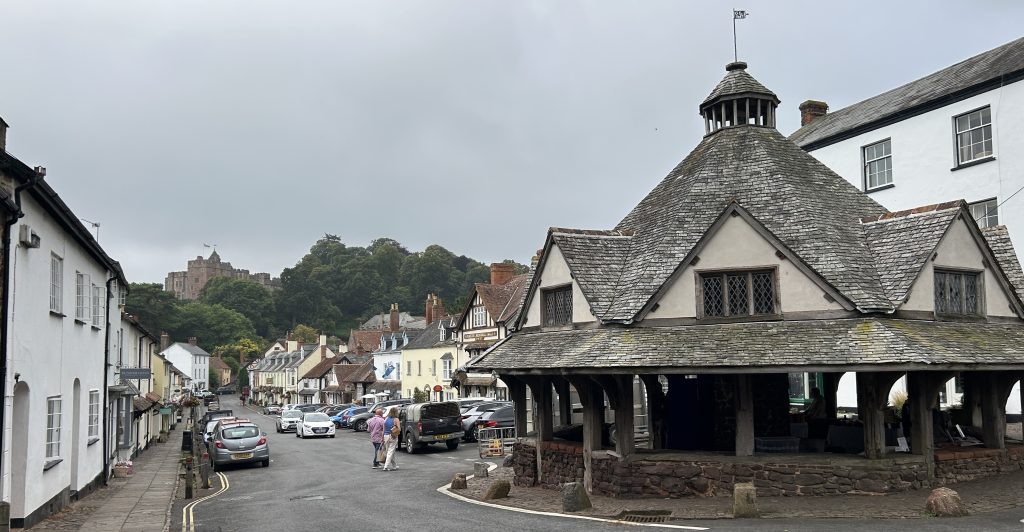
Lined with gift shops and restaurants, the street is as quaint as one would expect a Somerset village street to be. Most stores are closed since it’s still early, which is just as well. I need to carefully monitor my shopping if only because I’m traveling with a small carry-on and don’t have a spare centimeter for extra stuff.
On the Road to Lynmouth on Rabbie’s Small Group Tour
After Dunster, we travel on from Somerset into Devon. Along the way, we scale the 25% grade road (that’s really steep) that leads up from Porlock on the coast into Exmoor National Park and down the other side to the seaside town of Lynmouth (#2).
The views at the top are probably magnificent, but we need to take Matt’s word for it. The mist has rolled in, and the view is soft and gray with hints of heather and gorse.
It’s still beautiful in an atmospheric kind of way, and we do spot several wild horses.
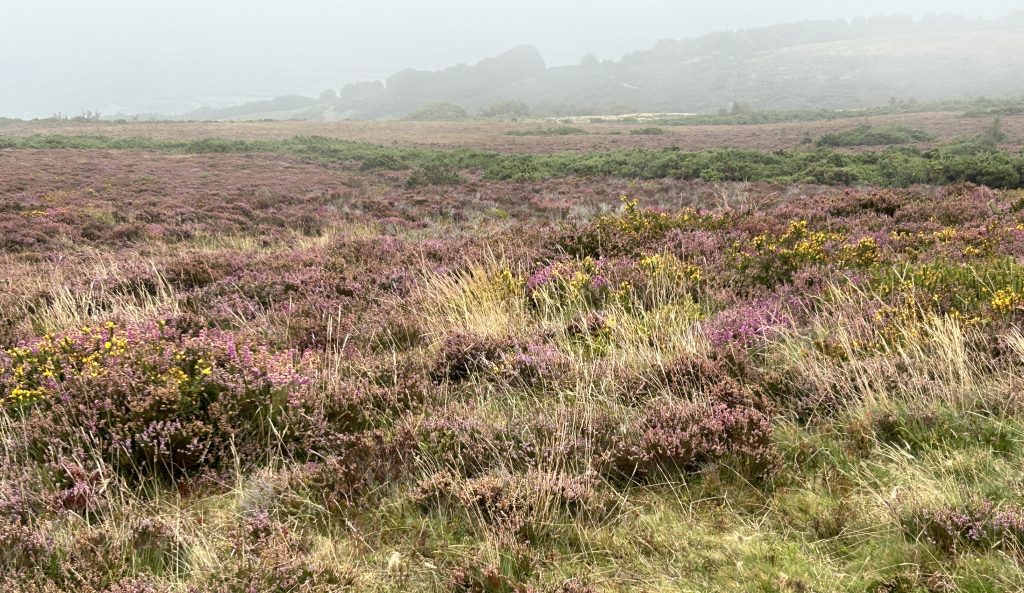
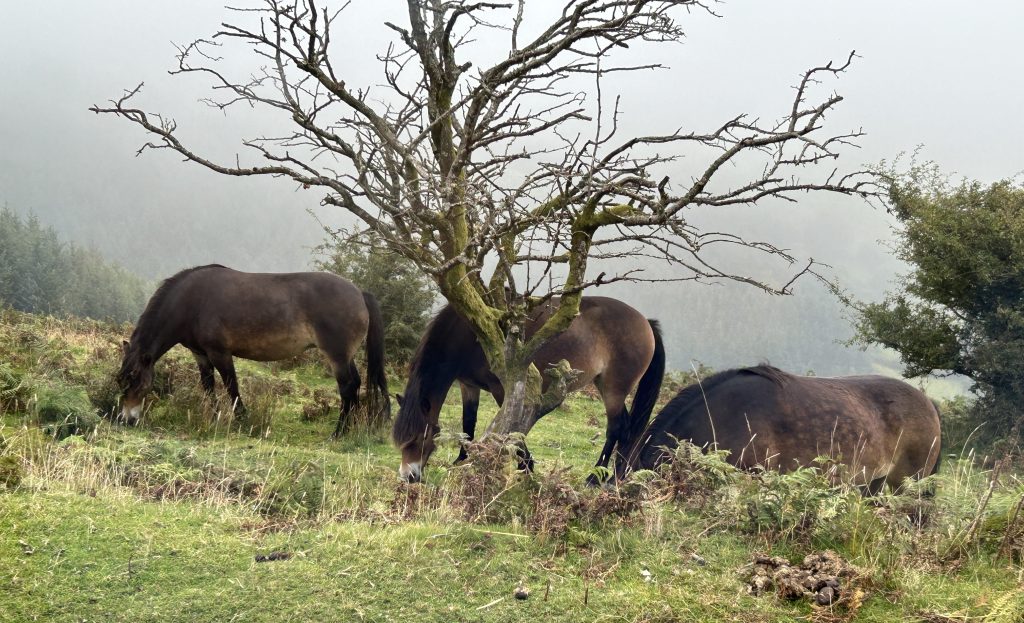
Lunch in Lynmouth
We stop for an hour in Lynmouth, which is just long enough for me to walk from the car park to the harbor, get a takeout lunch of fish and chips, do a spot of window shopping, and pop into the Memorial Hall that documents two seminal events in Lynmouth’s history.
I eat my ridiculously large serving of fish and chips on the pier overlooking the placid sea. The weather continues to be gray and dull, but the air is warm, and the streets of Lynmouth are still full of holidaymakers.
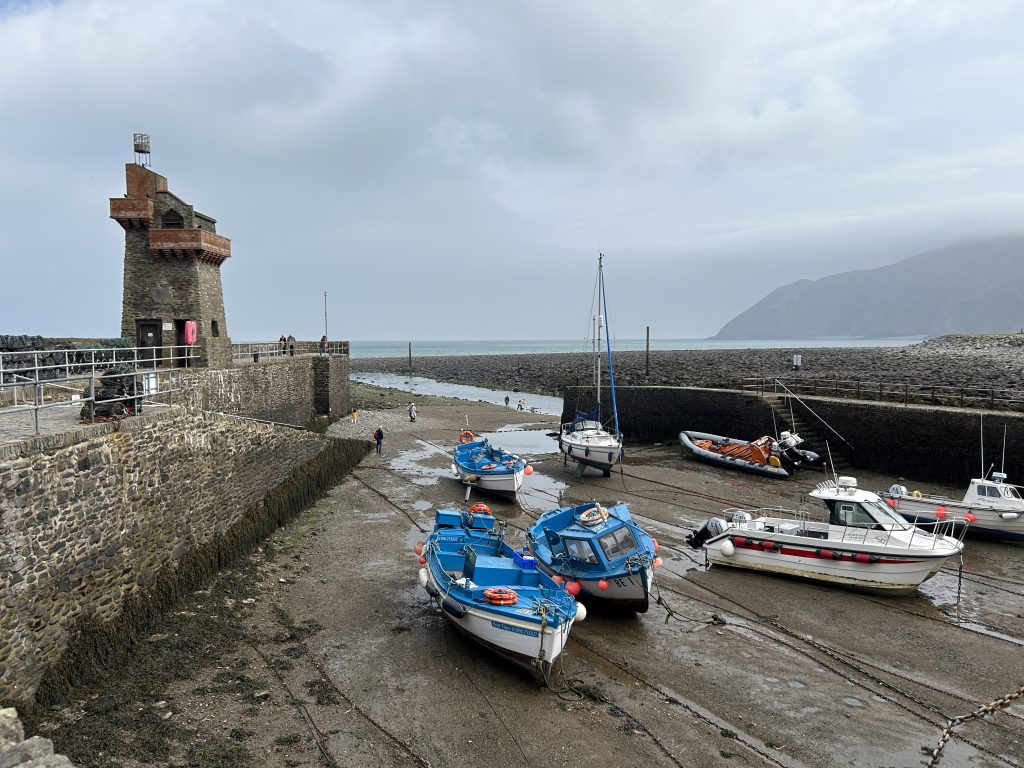
Flood of 1952
After lunch, I check out the Memorial Hall where I learn about the devastating flood of 1952 when over nine inches of rain fell in a very short time, resulting in a landslide that buried half the town and killed 34 people in the wider area, 28 of them in Lynmouth. The excellent exhibit in the Memorial Hall includes several blown-up photographs that show the devastation, a well put together and sobering memorial.
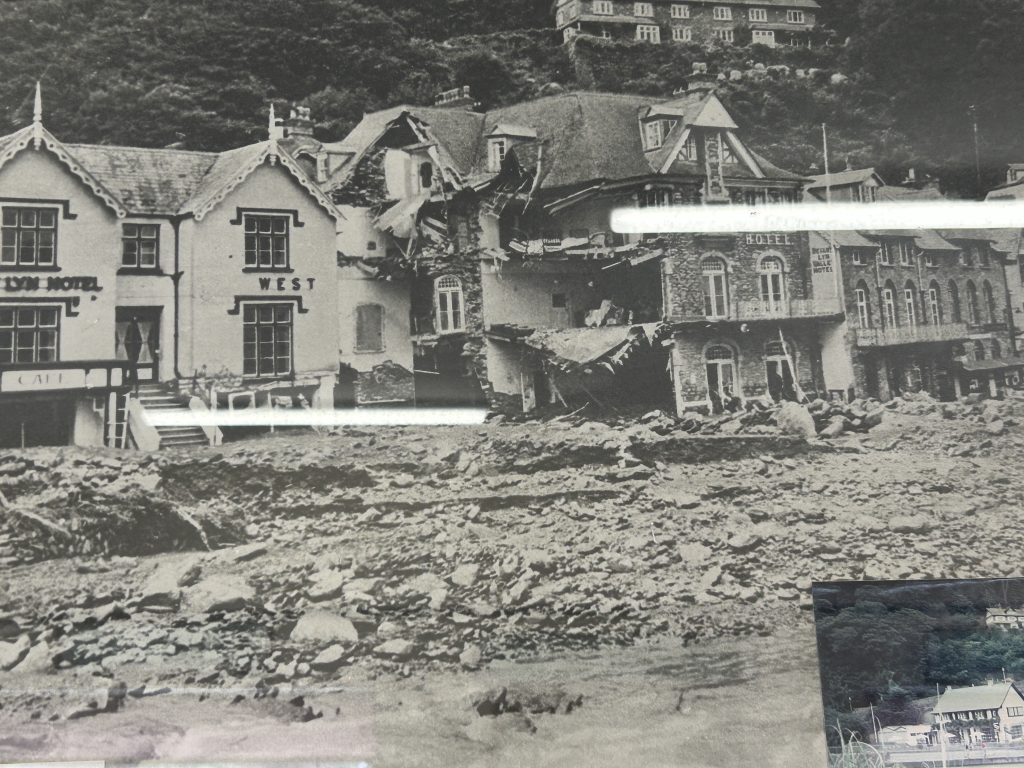
Rescue of the Forrest Hall
Lynmouth is also famous for a daring rescue undertaken in 1899 by local townspeople. When a ship called the Forrest Hall foundered off Porlock Weir—the town we’d just driven through on our way to Lynmouth—the seas were so rough that local fishermen couldn’t even attempt a rescue.
Rather than allow the people to perish, the intrepid fisherman of Lynmouth hauled a lifeboat called the Louisa up and over the extremely steep road we’d just traversed. The Memorial Hall includes a display of photographs about the rescue and its re-creation on the 100th anniversary in 1999.
On our way out of town, Matt plays us a song written to commemorate the rescue. The jaunty tune gets stuck in my head for hours.
Visit to Tintagel on Rabbie’s Small Group Tour
A lot of driving takes us across Devon and into Cornwall, finally ending at Tintagel (#3), the highlight destination of the day. The main attraction here is Tintagel Castle, a windswept ruin perched atop a craggy island on the rugged Cornish coast.
Was it the home of King Arthur? No. But that doesn’t stop the makers of souvenirs from exploiting Arthur at every turn.
Tourist shops line Tintagel’s main street leading to the long walkway to the castle. It’s colorful and tacky and crowded, although Matt tells us it’s quiet compared to what it’s like on Bank Holiday weekends.
Crossing the Bridge to Tintagel Castle
We start the trek down a very steep hill to the entrance to the castle. The word “castle” is used loosely. Folks expecgting to see a castle at Tintagel Castle (#4) will be disappointed. What you will see is an extremely dramatic setting, a very cool bridge linking the mainland to the island, and a smattering of crumbling stone walls—some quite large, most not.
Come prepared to walk and climb. A visit to Tintagel Castle requires a lot of walking, much of it over quite rough ground and up and down steep steps.
Getting to the island is almost as fun as climbing around it. A new bridge spans the gap between the mainland and the island. An open space of about four inches in the middle of the bridge allows for expansion and contraction during the often-ferocious weather that sweeps in from the Atlantic. The bridge to the ruins is sometimes closed and access cut off.
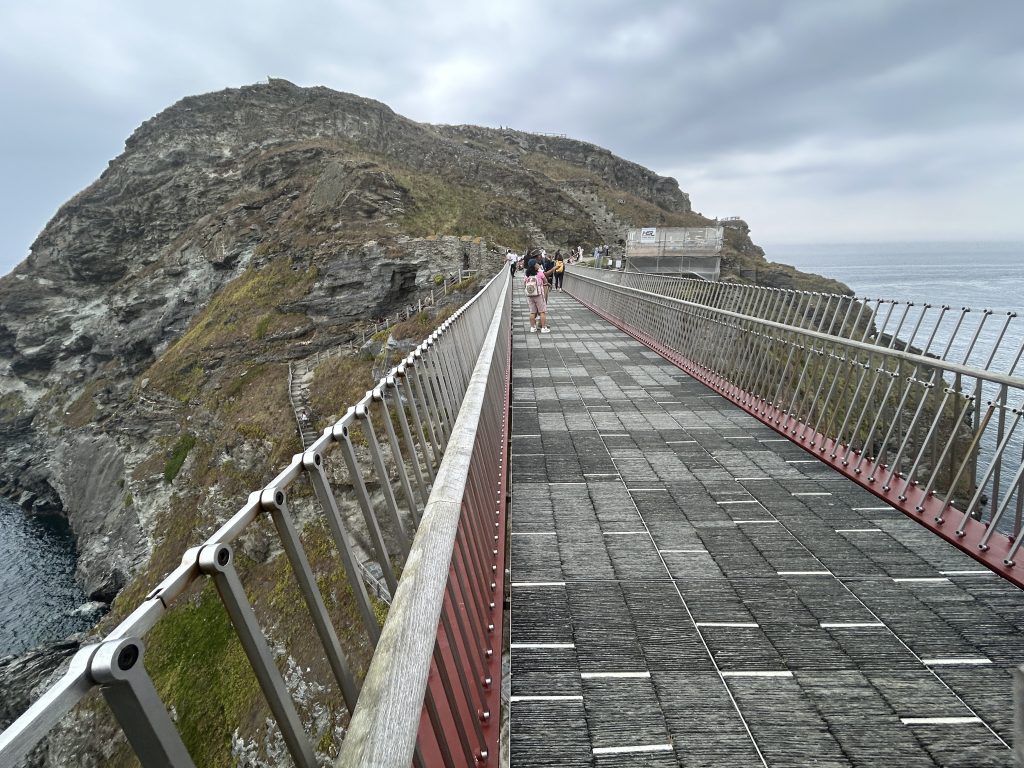
Exploring Tintagel Ruins
As I wander around the ruins, I try to imagine what the castle looked like back in the day. I can’t really picture it, but I do feel a sense of kinship with the early inhabitants. The view of the rugged Cornish coastline stretching to the east and west will not have changed. And if Arthur had hung out here, he’d have looked up at the same massive expanse of sky and felt the same fresh wind.
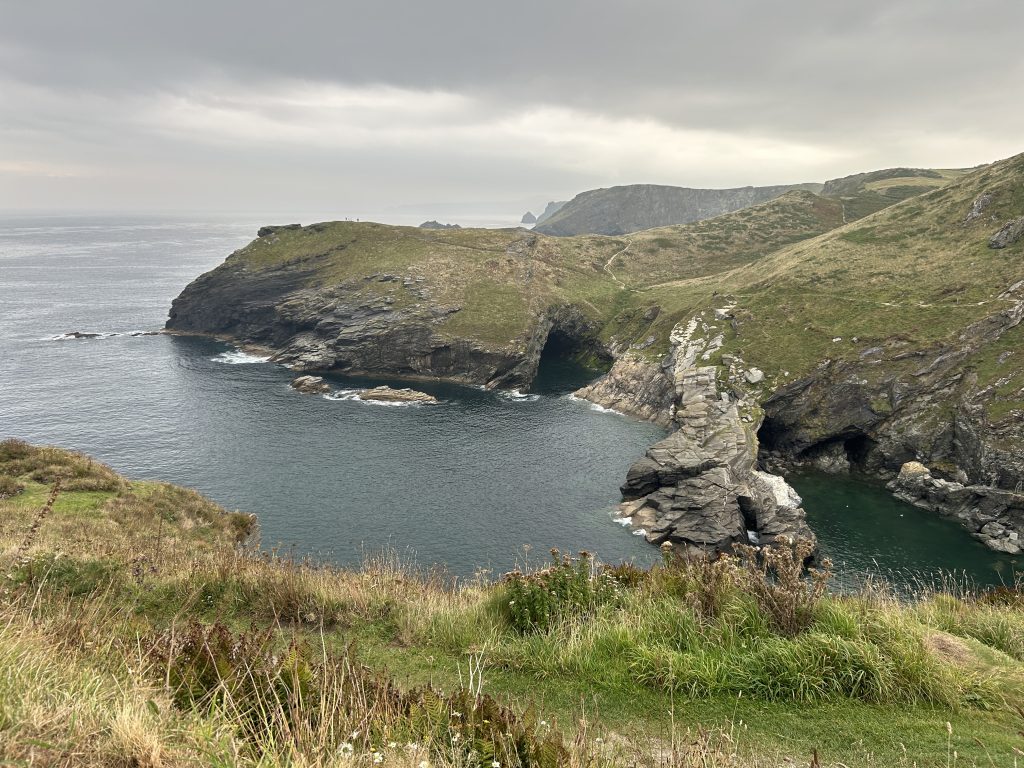
The large site swarms with people but doesn’t feel crowded. The castle has been rebuilt several times over the centuries because the walls keep crumbling in the elements. Hardly surprising. Bonus points for trying to build in such an inhospitable location, but in the end, nature wins.
I take a LOT of pictures.
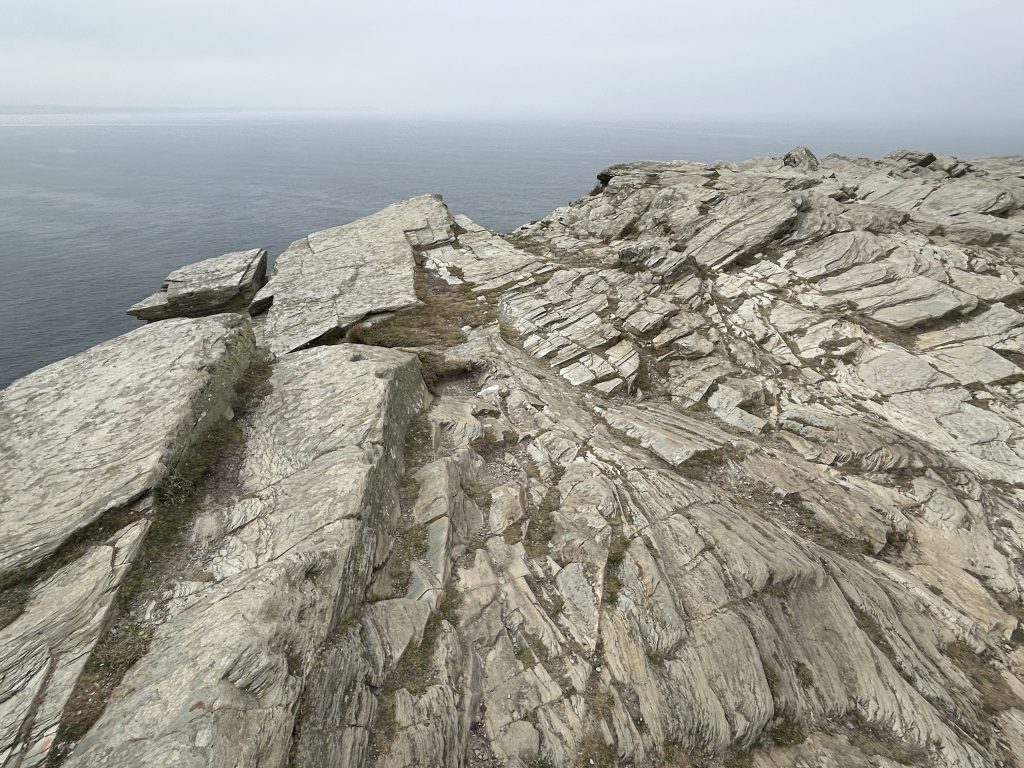
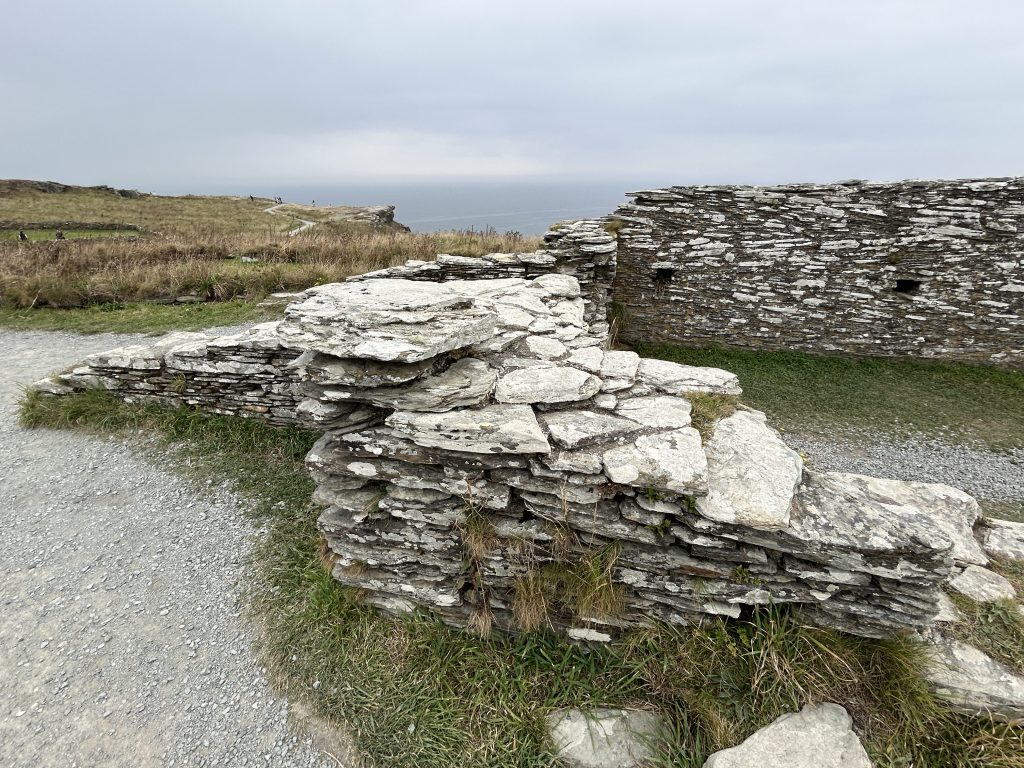
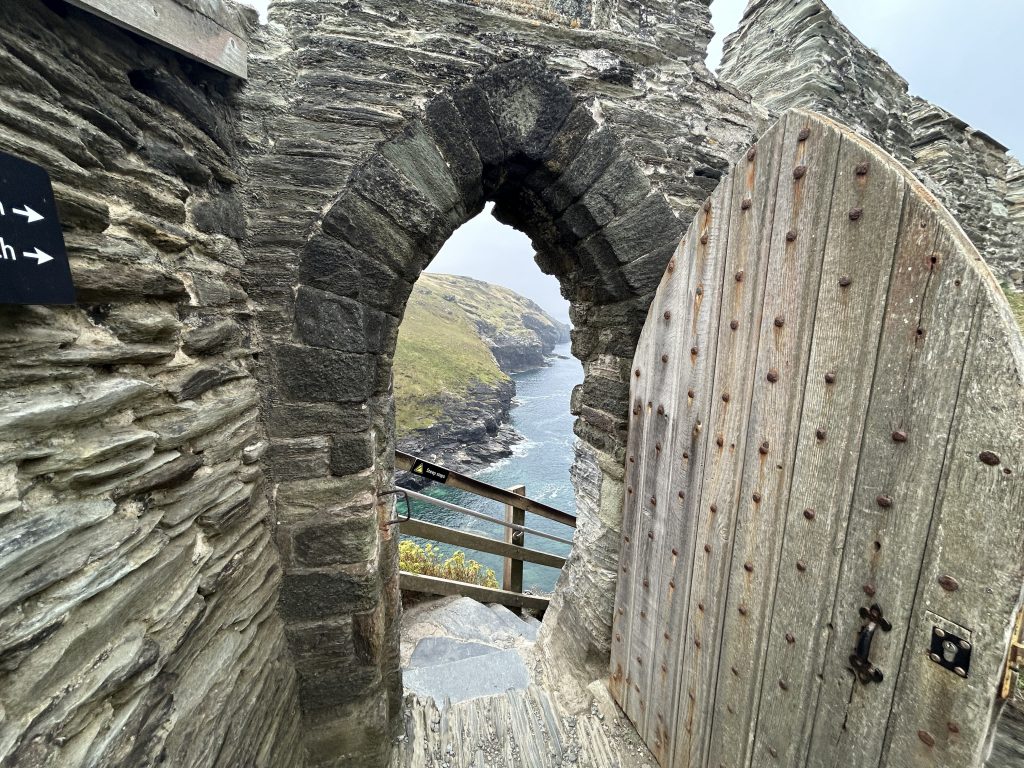
Back to Tintagel
After exploring the island, I descend an extremely precipitous set of stairs to the bridge. I have a choice. I can either walk back up a very steep hill, which is the way I came, or I can continue down to a road and catch a Land Rover back up to the car park.
The one-way trip costs ₤2.50—a bargain, particularly because all the up-and-down climbing has inflamed my arthritic knee. To be honest, it’s screaming.
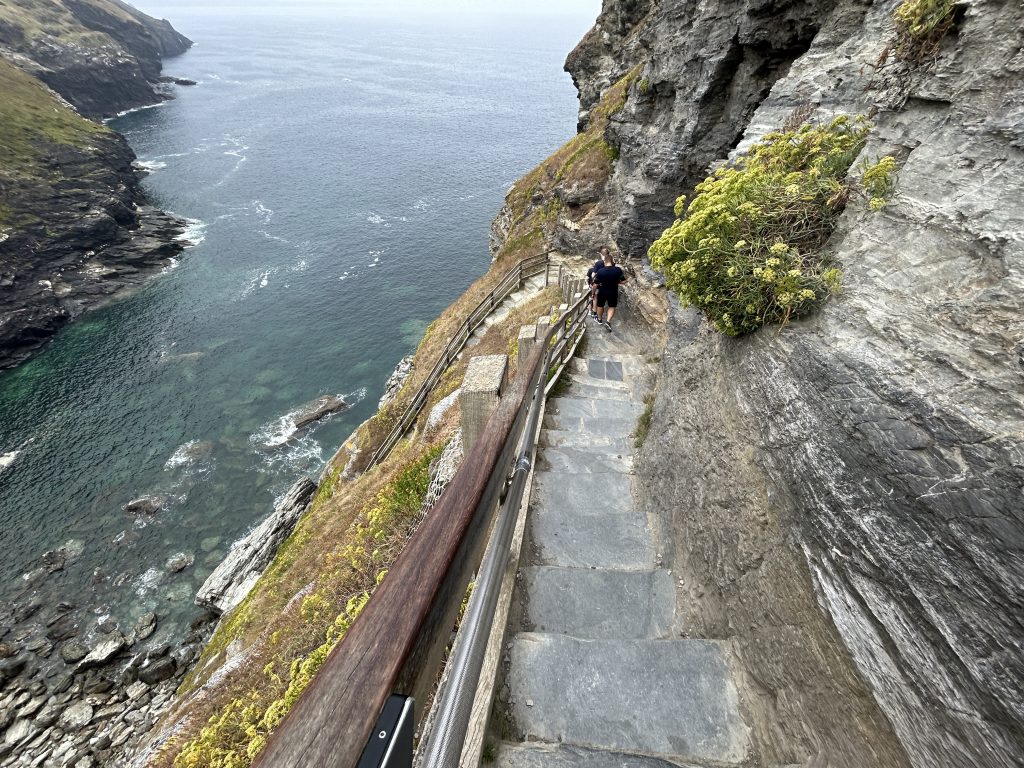
Old Post Office in Tintagel
Back in Tintagel, I discover the fabulous old post office—a National Trust property that draws me like a magnet. The ancient building dates from the 14th century. I gleefully explore the rooms, with their massive wooden beams, uneven floors, and white plaster walls.
I’m a sucker for old houses, particularly one this old. I know it’s been restored and likely doesn’t look like it did back in the day, but my imagination goes into overdrive, nonetheless.
The thick walls and tiny windows would keep in the heat but at the cost of light. It must have been very gloomy, particularly at night with light provided by only a few guttering candles.
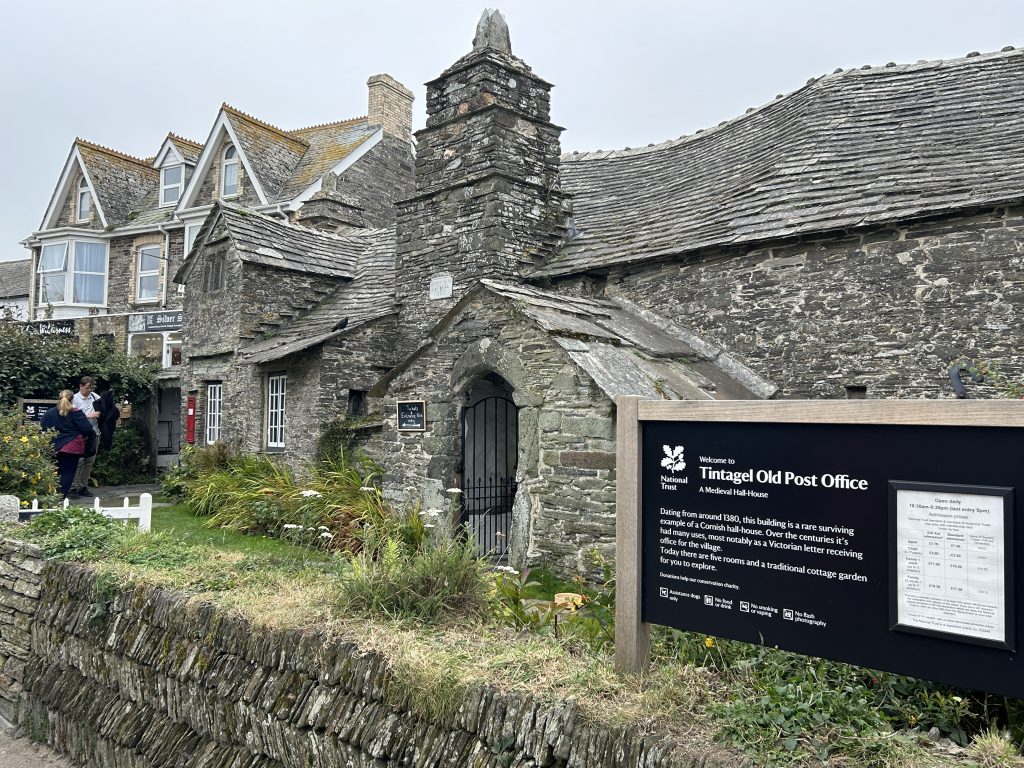
In the beautiful English garden behind the old post office, I chat with one of the National Trust guides about history and my novels. She’s lovely!
The Tintagel Old Post Office is open every day, with visiting hours from 10:30 to 17:30.
Rum in Tintagel
Before boarding the bus, I stop in at a place that sells local gin and rum. The shopkeeper is very accommodating. He describes the impressive range of rum-flavored spirits. I buy a small bottle of cinnamon flavored rum which I take a tipple of later in my room. It’s delicious; I wish I’d bought more!
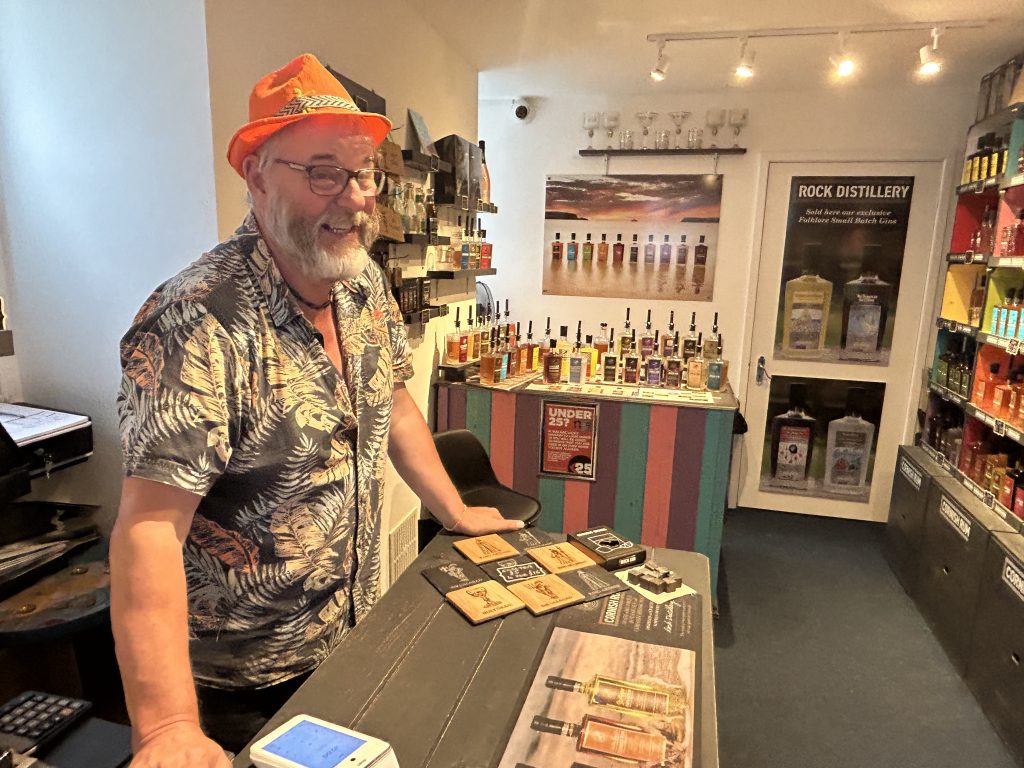
Dinner in Falmouth
The first and second nights of the tour are spent in the Cornish town of Falmouth (#5) on the south coast. I’ve chosen the Lerryn Hotel—a large guest house overlooking the sea. My room is spacious and comfortable and the breakfast on both mornings is very tasty. I opt for smoked salmon and scrambled eggs on day 1 and porridge with cream and honey on day 2.
After getting settled, I walk down the hill to the harbor in search of a restaurant. I pass the Maritime Museum (#6)—a modern building that looks very intriguing and advertises an exhibition about pirates which, alas, I will miss. On both of our nights in Falmouth, we arrive back long after the museum has closed and leave both mornings before it opens.
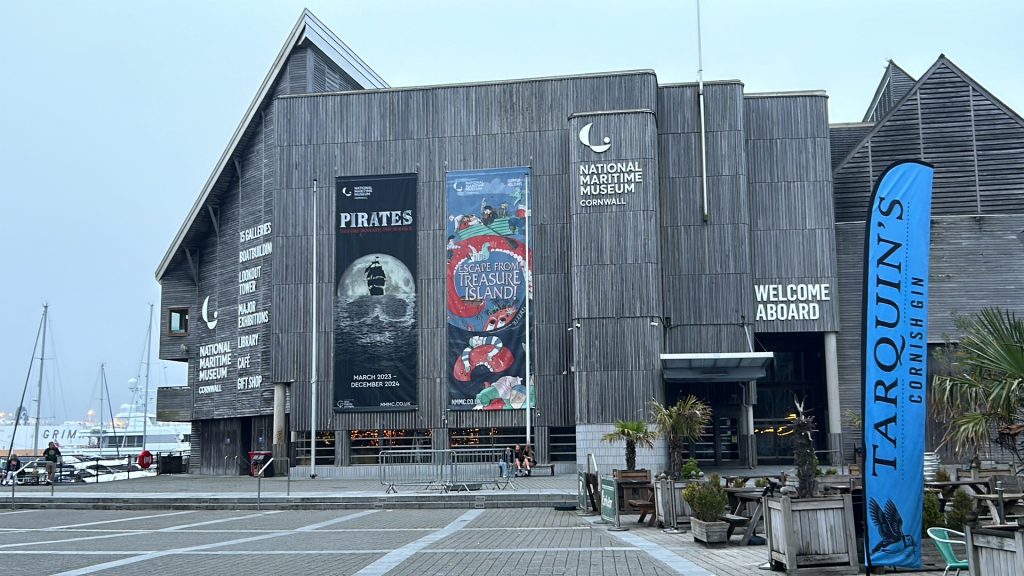
A General Note About Guided Tours
One drawback of a guided tour is that you’re at the mercy of someone else’s schedule. If the itinerary doesn’t include something you want to see, then you’re out of luck. You must decide if the convenience of a tour is worth the lack of flexibility. Because I’m traveling on my own and don’t want to drive, taking a tour makes sense. Hopefully one day I’ll return and do a driving holiday. There is a LOT to see in this part of the world.
Dinner at The Hub in Falmouth is excellent: a dressed crab salad with lovely fresh bread and salad, and a large glass of Pino Grigio.
After dinner, I meet up with the American couple who are dining close by and walk back to the hotel. They are staying around the corner, and I’m grateful for the company in the darkness.
A note about accommodation on a Rabbie’s tour. You can choose the level of accommodation you want, and they will book appropriate places, or you can book them yourself. I can recommend both The Lerryn in Falmouth and Leonardo Hotel Exeter, which is a cookie-cutter chain hotel, but very comfortable with excellent food.
Day 2: All Day in Cornwall on Rabbie’s Small Group Tour of Southwest England
The next morning dawns soft and mizzly, with the sky and the sea meeting in a single sheet of gray. But the air is fresh and the seagulls loud, and I’m excited to explore this scenic corner of Cornwall. Matt has promised us a full day of sightseeing with short drives.
Visit to Porthleven on Rabbie’s Small Group Tour
Our first stop is the seaside town of Porthleven (#7) which is apparently a mecca for foodies. Matt tells us about a terrible storm many years ago during which the sea surged into the sheltered harbor and swept a police car right off the pier, killing both police officers inside.
I snap a photo of the warning sign that greets us at the start of the pier.
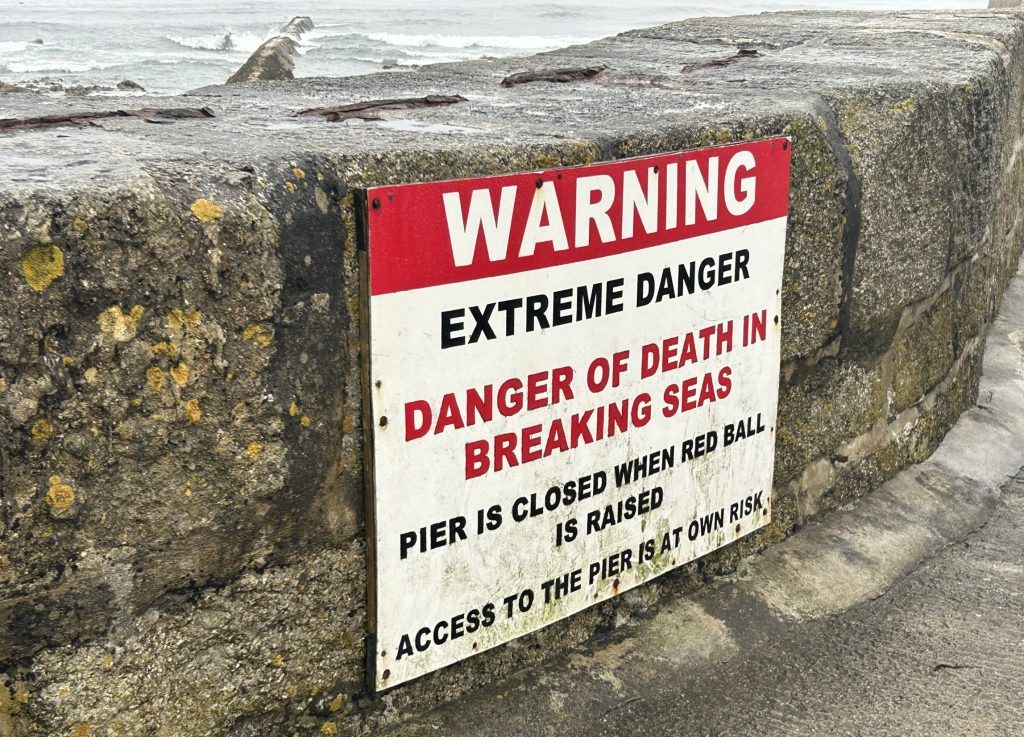
The pier is open and empty in the rain. It’s a spectacular setting even in the gray and the wet.
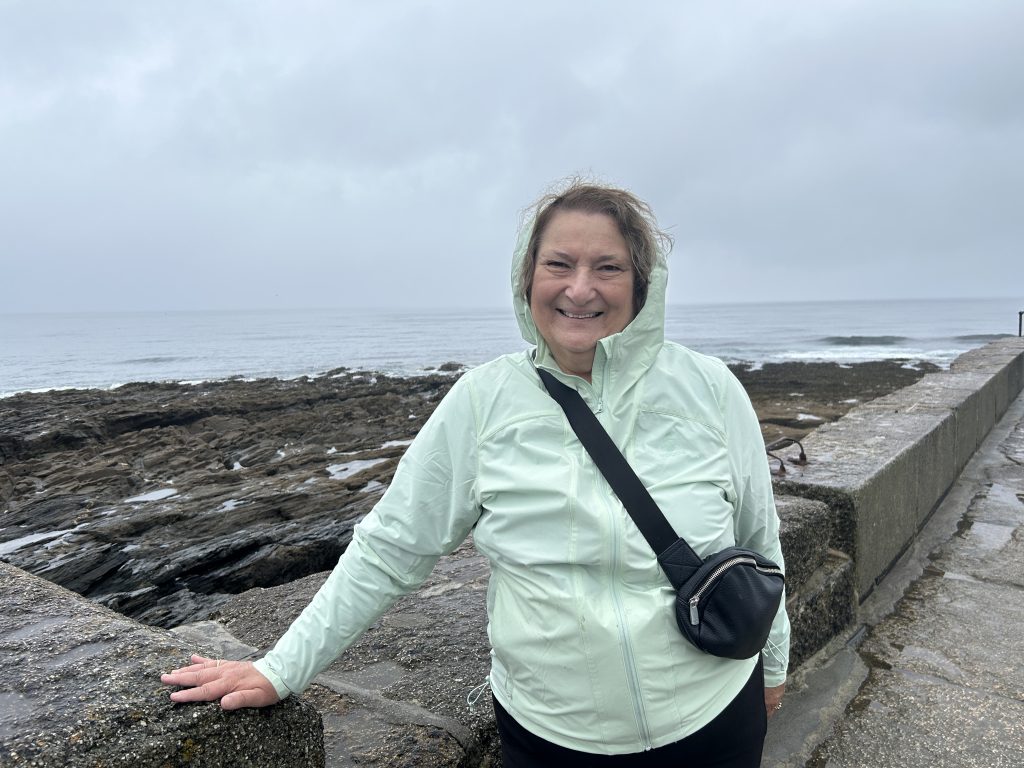
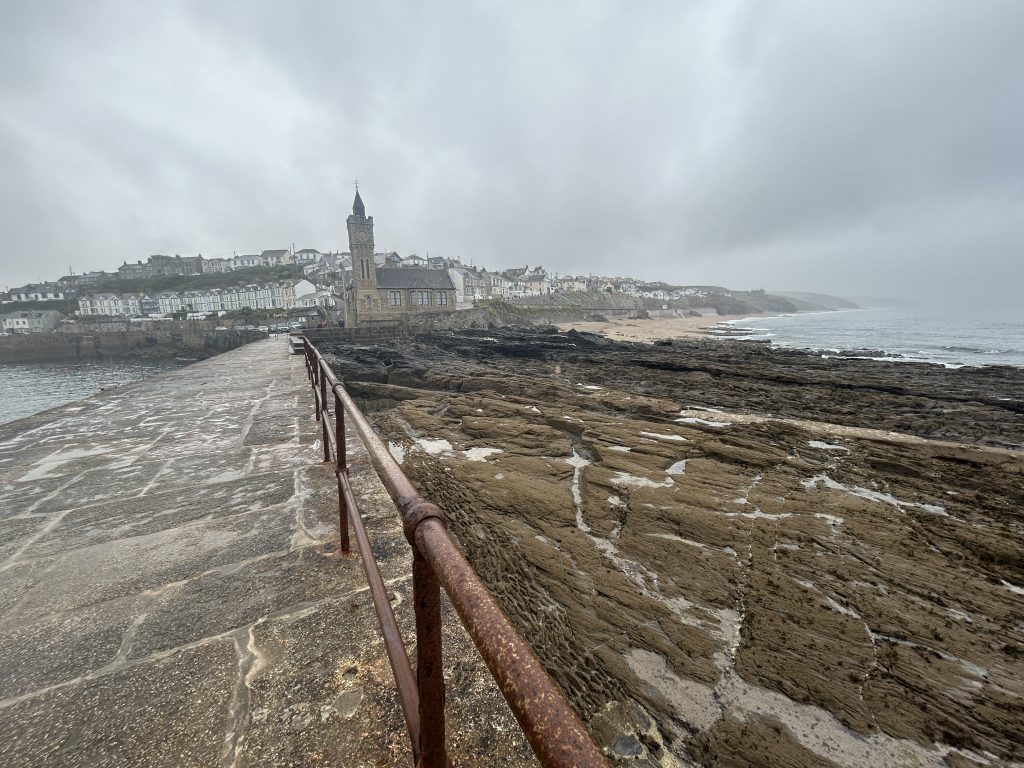
We stop at a coffee roastery to sample some locally roasted coffee. The roastery is a happening place with lots of employees bustling around the facility visible through large windows in the café area.
Minack Theatre on Rabbie’s Small Group Tour
At 11:30, we have a reservation to view Minack Theatre (#8). This place is a revelation. I’d never heard of it and so was delighted to discover a multi-level series of turf-covered benches stretching from the edge of a clif sea up a steep hill.
Minack Theatre is the creation of the indomitable Rowena Cade after she saw an open-air production of A Midsummer Night’s Dream in the 1920s. She offered her cliffside garden for staging performances and almost 100 years later people are still coming to this dramatic setting to enjoy live theater.
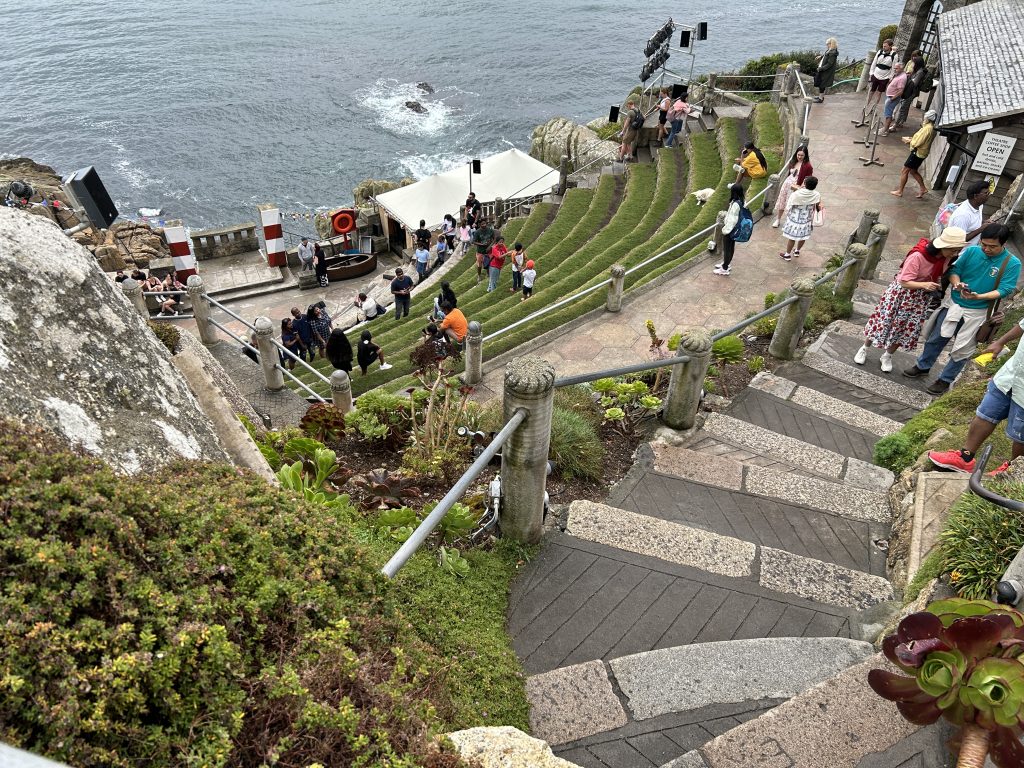
I go into the exhibition center to watch a film about the origins of the theatre and am particularly interested in the interviews with various performers about the challenges of performing in a theater open to the elements—wind, rain, cold, sun.
Occasionally, the weather is so bad that the theatre has to be closed and the performances cancelled.
One of the highlights of the site is the plethora of exotic succulents in all sorts of twisty shapes. I can’t stop snapping pictures!
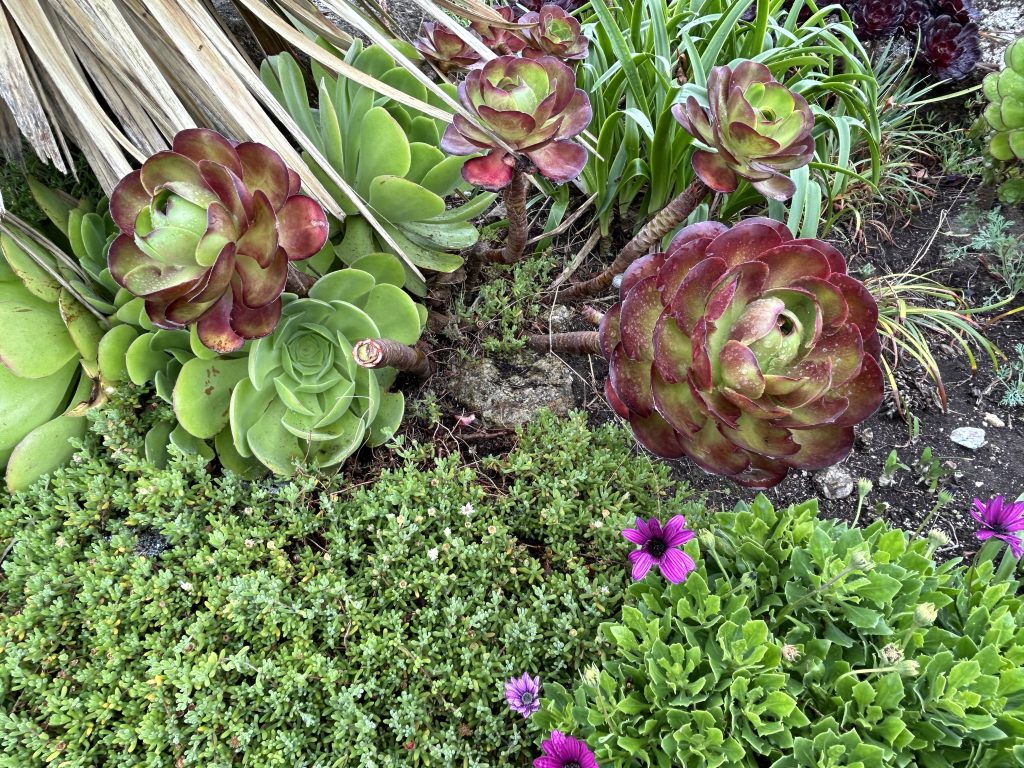
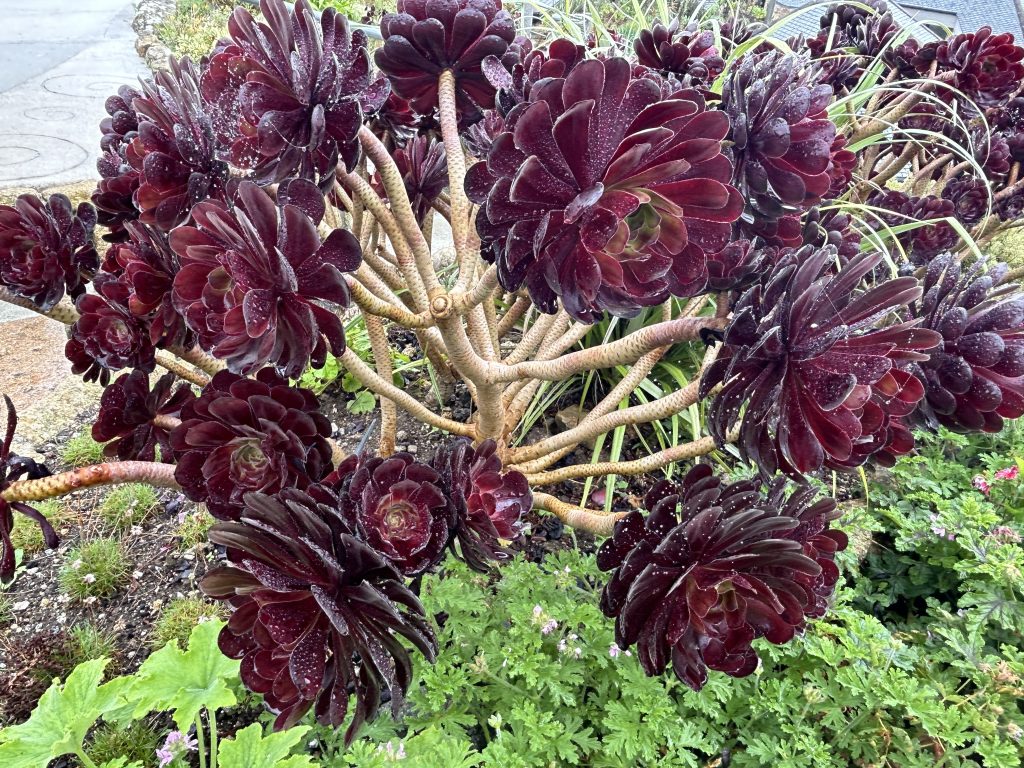
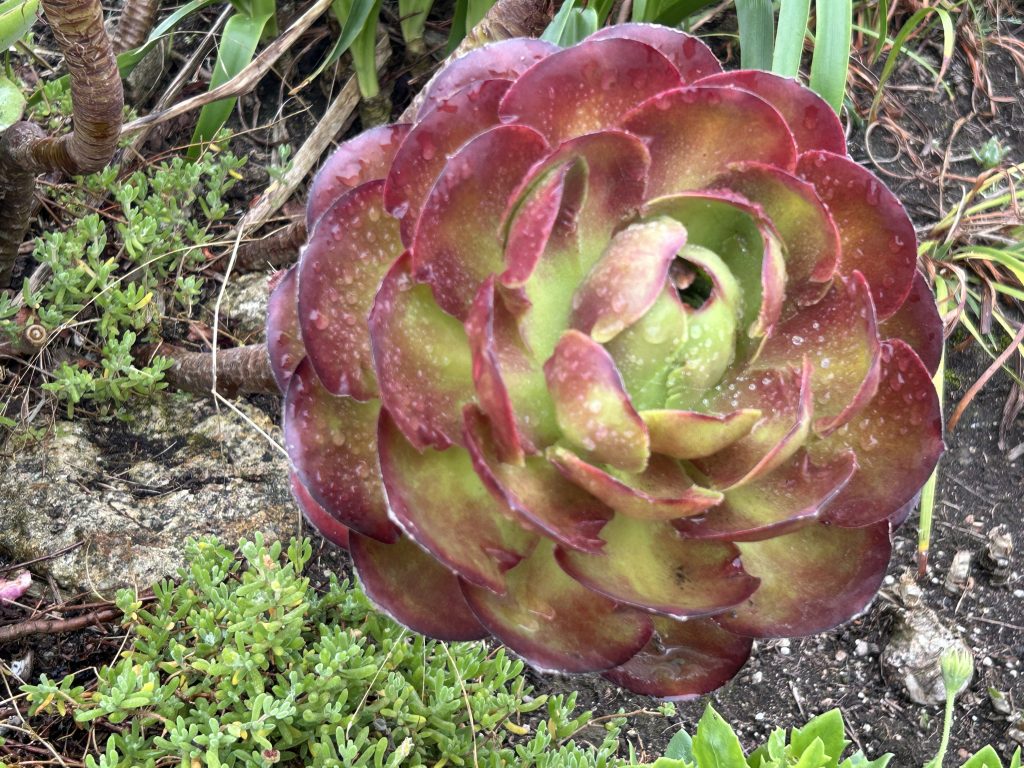
If I ever travel again to Cornwall—preferably under my own steam—I’ll definitely book tickets for a performance at Minack Theatre. Talk about an Artsy Traveler experience!
Land’s End
A short drive takes us from Minack Theatre to Land’s End (#9). The last time I visited Land’s End was in 1974 when, at age18, I traveled with two friends all around Britain. Somewhere in a box is a picture of the three of us at the Land’s End signpost.
I remember the place as windswept and pretty much empty apart from maybe an ice cream truck.
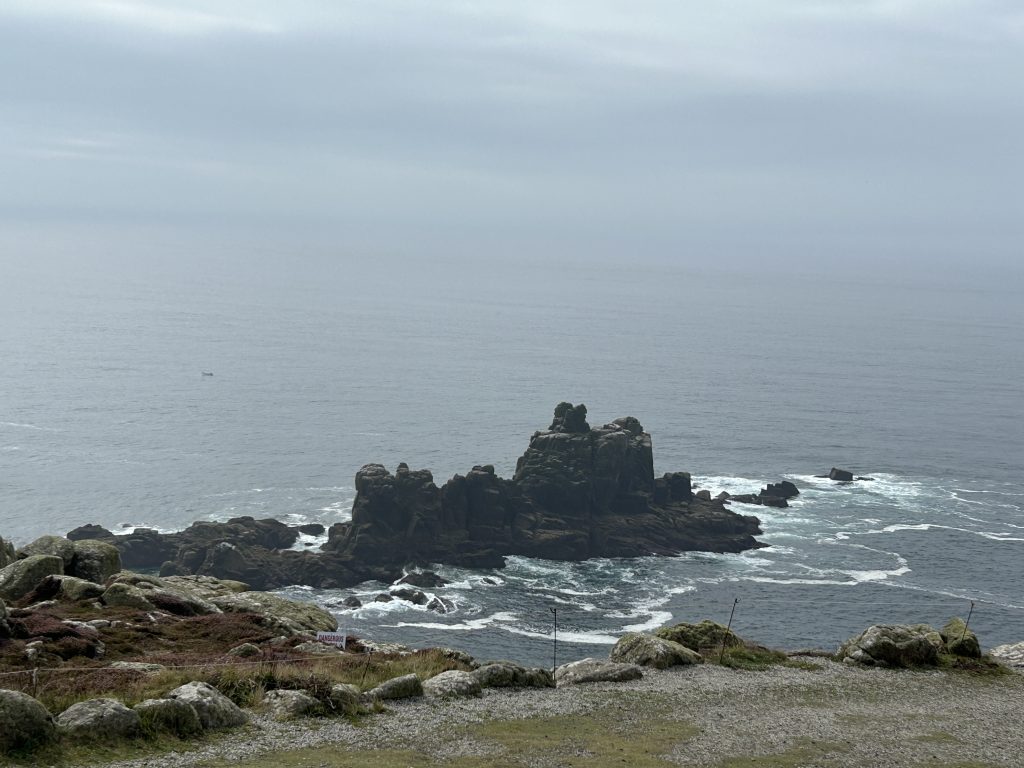
That’s all changed now. A theme park franchise has taken over the area and made it horrendously commercial. Fortunately, no amount of tackiness can detract from the stunning view of rocks and ocean that awaits you once you’ve threaded the gauntlet of souvenir stores and fast-food joints along with a bunch of weird, out-of-context attractions.
Now, you’ll pay ₤10.99 to have your picture taken next to a signpost on which an attendant affixes letters designating your home town and its distance from Land’s End.
Needless to say, I decline.
Tin Mines of Botallack
This stretch of Cornish coastline is known as the Tin Coast and was home to numerous tin mines, the vestiges of which are still visible. The Tin Coast has been the site of mining for over 2,000 years, with the industry peaking during the Industrial Revolution when the demand for tin was high.
At Botallack (#10), we stop to view the ruins of several mines and walk out to the cliff. The word bleak comes to mind, perhaps because it’s gray and rainy, but more so because I can’t help thinking how horrific life must have been for the miners.
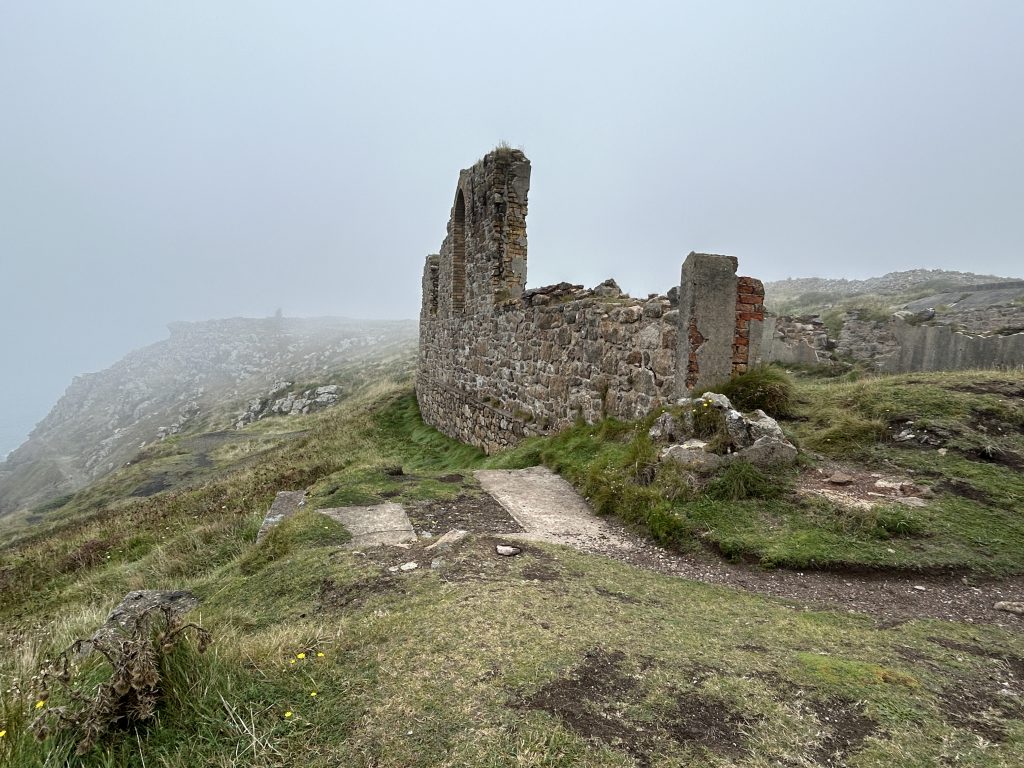
Many of the mines extend hundreds of meters out to sea and hundreds of meters below the seabed. I shudder to think of how claustrophobic the conditions must have been and how many of the workers died.
St. Ives on Rabbie’s Small Group Tour
The major destination for Day 2 is the seaside town of St. Ives (#11). One of its many claims to fame is its association with several prominent 20th century artists, including Barbara Hepworth.
Tate St. Ives
Matt drops us right in front of the Tate St. Ives. I hadn’t realized there was a Tate here, so imagine my delight! I make it my first stop. The beautiful building houses ten galleries filled mostly with post-war abstract art along with a special exhibition of the very colorful work of Beatriz Milhazes.
I arrive in Gallery 1 in time to hear a short talk by one of the curators about Robert Lanyon, an artist I had never heard of. Unlike most of the artists who flocked to St. Ives throughout the 20th century,
Robert Lanyon was born in St. Ives. He was also a foremost proponent of post-war abstract art. The curator tells us that St. Ives was attractive to artists such as Barbara Hepworth and others because of the beauty of its light and the landscape.
He emphasizes three words: abstraction, light, and landscape.
Commentary on Porthleven by Peter Lanyon
The curator presents a lively commentary of a work called Porthleven by Peter Lanyon. The large, powerful work was Lanyon’s contribution as one of sixty artists chosen to represent Britain at the Festival of Britain in 1951. I’d heard about the Festival at the Museum of English Rural Life a few days earlier. Funny how you can go a lifetime never hearing about something and then suddenly hear about it twice in three days.
The piece is a multi-layered depiction of Porthleven, where we’d visited that morning. The curator’s explanation really brought the painting to life. Apparently, David Bowie was a big collector of Lanyon’s work. He said his work may not be the most beautiful in his collection, but they were the pieces he looked at the most.
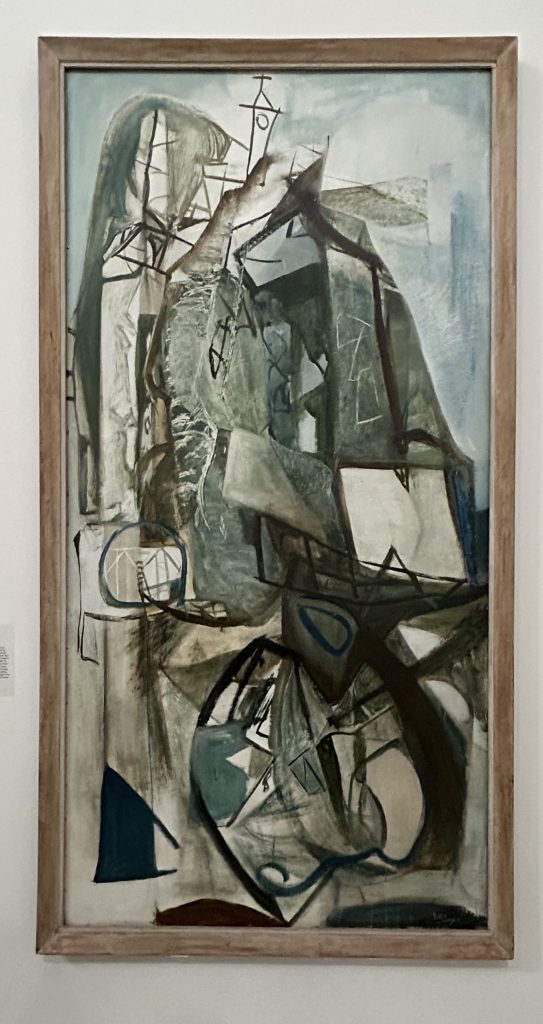
Touring the Tate St. Ives
After the short talk, I tour the various galleries and get pleasantly lost in a reverie of art appreciation. Here are three of my favorite pieces.
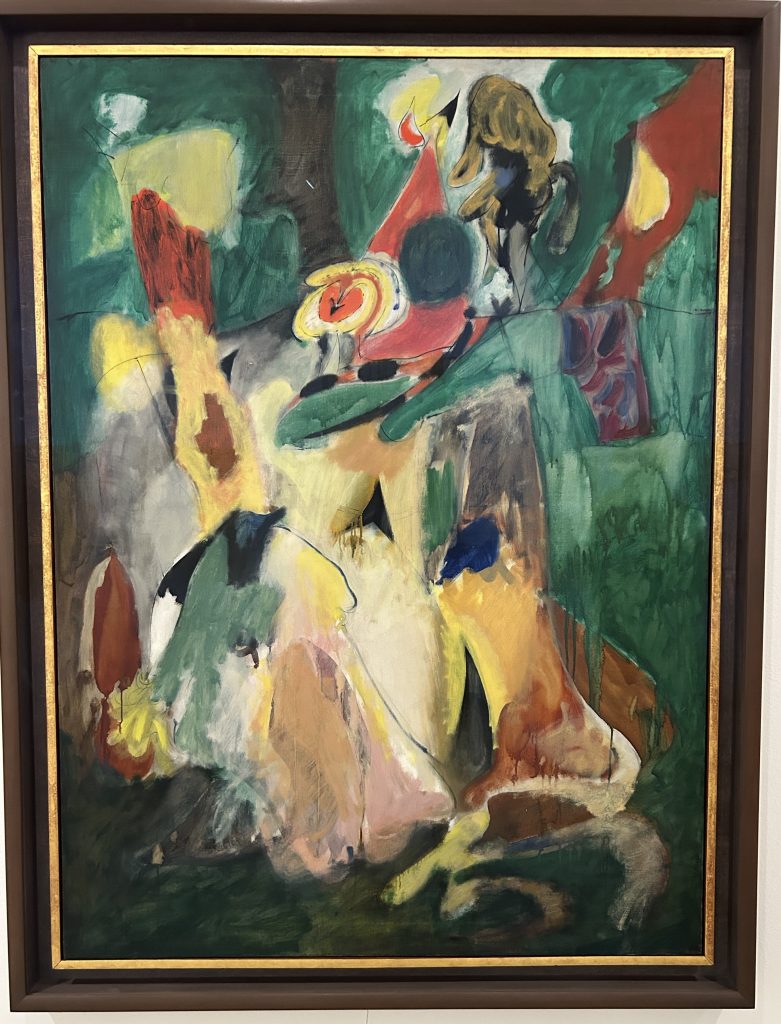
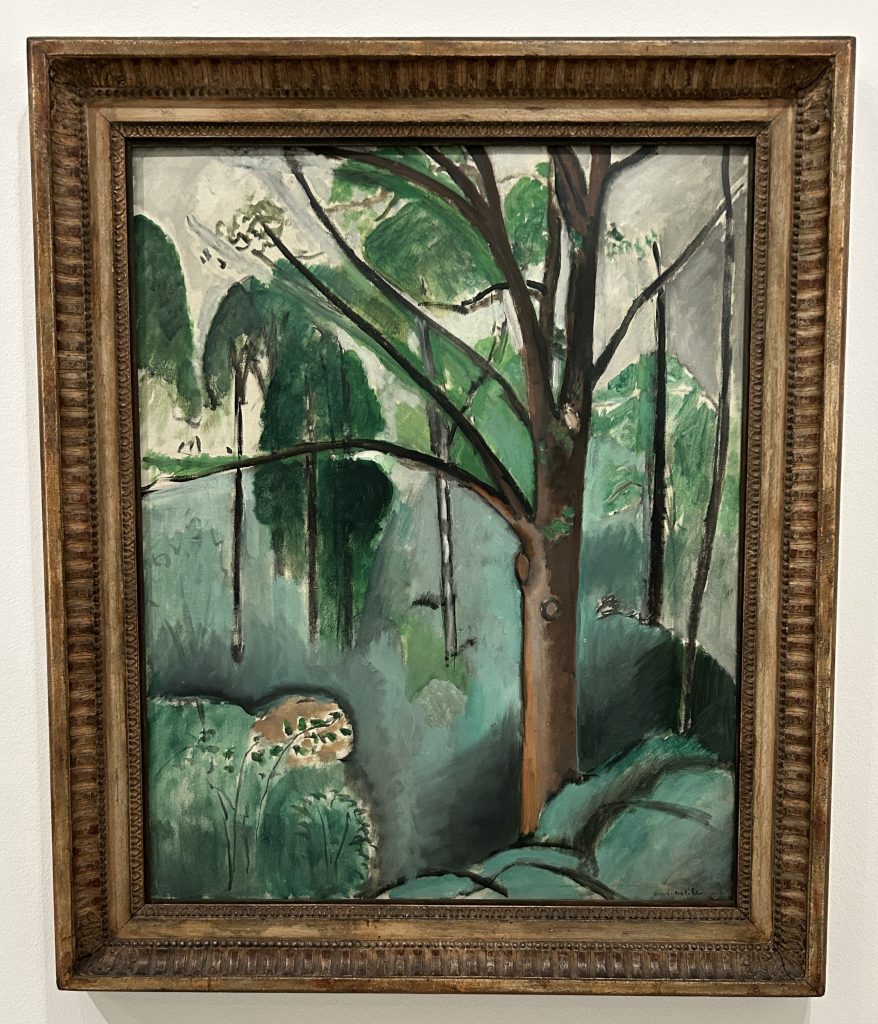

Commentary on Lost Mine by Peter Lanyon
I finish my swing through the galleries in time to catch a second talk about Peter Lanyon by the same curator. Thankfully, there is seating for this talk. My knee is tender after yesterday’s hike around Tintagel and I sink gratefully onto a bench to listen.
The curator describes a piece called Lost Mine that depicts a tin mining disaster. Since I’d only just visited the remains of the tin mines at Botallack, viewing the painting felt particularly relevant.
The curator describes what I’d suspected when viewing the tin mines—the dreadful conditions the miners endured to extract tin and copper from under the sea. Some of the shafts went 400 meters into the seabed and then a mile out to sea. When there was a flood—an inundation as it was called—there was no way out. Deaths were alarmingly common in an age when safety standards were unknown.
Lanyon’s visual depiction of a mining disaster is visceral and immediate. The curator’s description of the various elements make sense of the painting and reveal Lanyon’s skill.
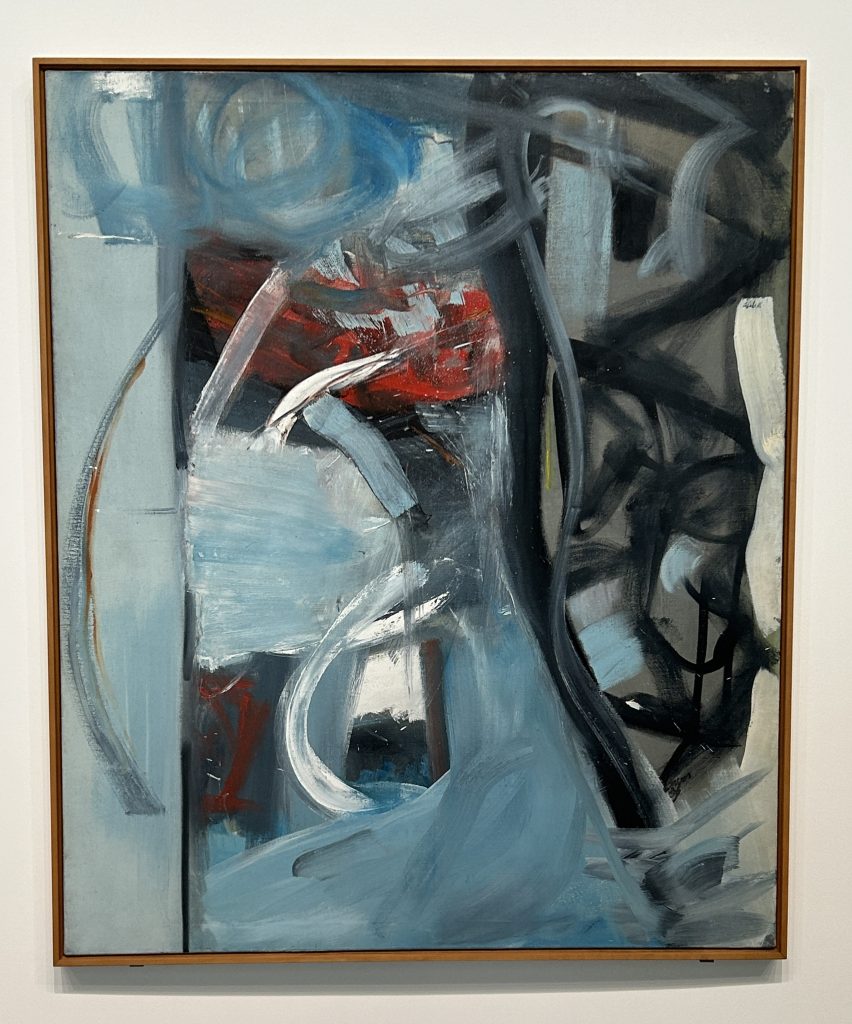
Lost Mine by Peter Lanyon
Exploring St. Ives
After touring the Tate, I mosey into the main center of St. Ives, a pleasing warren of narrow streets and alleys. The main street is lined with shops—gifts and food and art. But unlike some of the places I’ve visited so far in Cornwall, most of the shops feature locally made art and gift items rather than imported tat.
At the end of the street, I discover that St. Ives is a peninsula, with the ocean on one side where the Tate is and a beautiful harbor on the other. Surfers ride the waves on the ocean side, and boats bob serenely on the harbor side.
It really is picture perfect. No wonder the place is mobbed. It would be wonderful to come here off-season—rent a house overlooking the water and write. I wouldn’t be the first author to have done so! As a child, Virginia Woolf lived here in Talland House, which is the title of a novel inspired by Woolf by author Maggie Humm. I interviewed Maggie about Talland House and its connection to St. Ives for The Art In Fiction Podcast.

I see signs to Barbara Hepworth’s studio and garden, but I decide I don’t have time for a visit. At least I have even more incentive to return to St. Ives.
Back to Falmouth
After St. Ives, we head back to Falmouth. It’s been a long day and I’m happy to pick up a takeaway dinner to eat in my room. Before darkness falls, I stroll along the sea front to admire the view and listen to the constant cawing of the seagulls. Falmouth seems like a very pleasant town and I’m sorry there’s not more time to explore it.
Day 3: Cornwall to Devon on Rabbie’s Small Group Tour of Southwest England
The sun decides to come out as we leave Falmouth and the Cornish coast and drive inland across the sunlit patchwork of green that is central Cornwall. Huge clouds fill the big sky, and everyone is in good spirits.
Our small group is easy to deal with, which I’m sure is a relief for Matt, and makes for a tranquil tour for me. Everyone returns to the bus on time, and no one has any complaints.
Jamaica Inn on Rabbie’s Small Group Tour
The first stop of the day is the Jamaica Inn (#12), made famous by Daphne du Maurier. When she and a friend were lost in the fog, their horses led them to the inn. As a result, du Maurier wrote her famous novel Jamaica Inn. Several films and a TV series have been filmed here.
I’m looking forward to touring the museum, but, alas, I can’t find it in the warren of rooms all serving food. Basically, Jamaica Inn is a restaurant and gift shop attracting coach tours. I do, however, buy a novel by Daphne du Maurier because I’ve never actually read any of her work.
Traversing Bodmin Moor
In the sunlight, the gorse and heather and cows and towering clouds in a wide sky above Bodmin Moor (#13) captivate my imagination. We’re on our way across the moor to the tiny town of Minions where there is an ancient stone circle. But first, a quick stop to get acquainted with some lovely Cornish hairy cows.
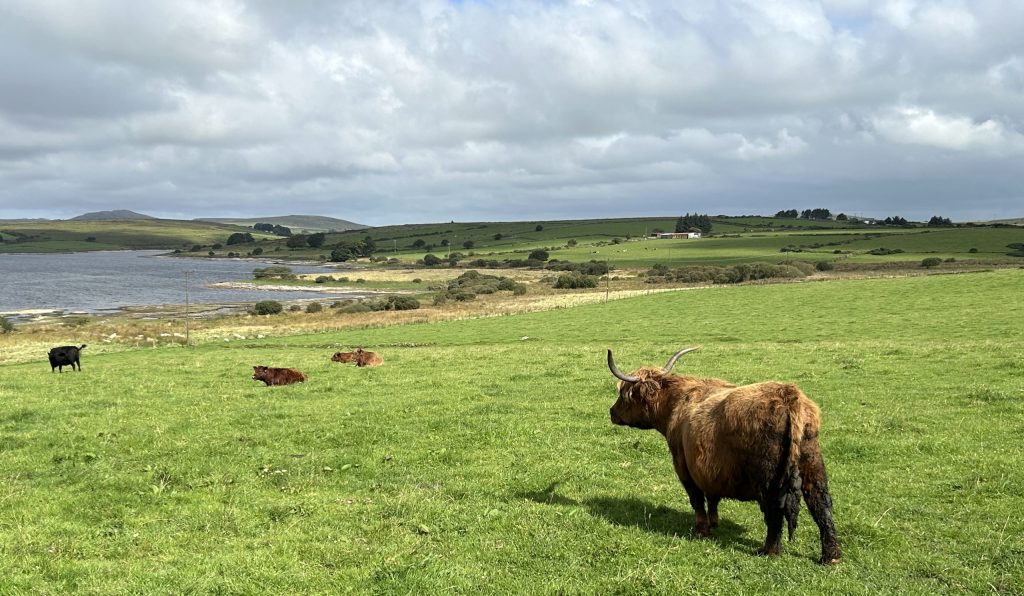
Matt skillfully drives us along narrow roads with densely packed hedgerows on either side. He tells us that the foliage masks stone walls just waiting to dent passing cars.
We stop in a sylvan dell to view an ancient bridge, called a carriage bridge, that includes outdents to allow vehicles to pass. Matt leads us in a quick game of Pooh Sticks. Mine emerges from under the bridge in third place.
I love this stop! There are no visitors or ice cream trucks in sight; it’s just the six of us in a forest with the smell of vegetation on the brink of decay—the smell of summer ending.
The Minions
We drive on into Dartmoor en route to the tiny town of Minions (#14). Apparently, the town sign is often pinched thanks to the popularity of the Minions movies. Our destination is the Hurler Stones—an ancient stone circle set atop the windy moor.
I do love a good stone circle and this one is impressive.
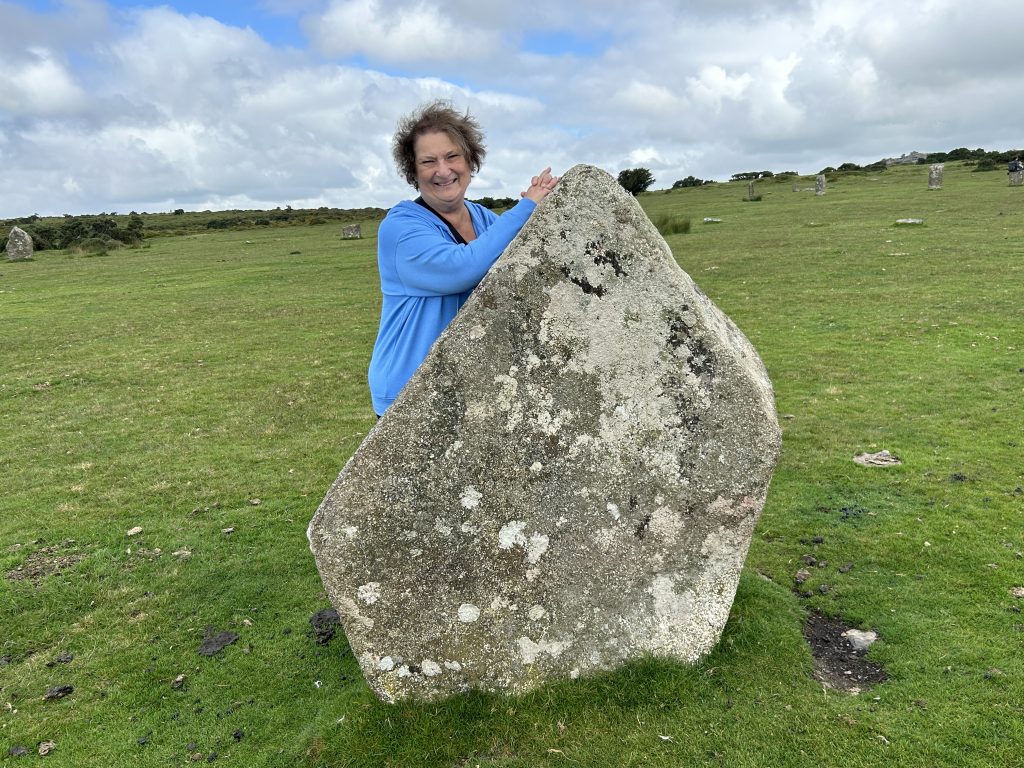
The stone circle is named The Hurlers because in olden times, a group of men dared to play hurling on the Sabbath. To punish them, the devil rose from hell and turned them to stone.
The true origins of the stone circles (there are three of them) is not known, but they are definitely very old.
As we walk up to the stones, we need to watch every step to avoid many still-steaming contributions by horses, sheep, and cows.
Lunch Stop in Tavistock on Rabbie’s Small Group Tour
We stop for lunch stop in Tavistock (#15), a pleasant little town. I have just enough time to grab a quick lunch—a chicken, bacon, and leek Cornish pasty (excellent) — and check out the indoor market that mostly features antiques.
The American woman on the tour is into antiquing. I run into her outside and tell her she must go in and take a look. With ten minutes to spare before the bus leaves, she manages to make two purchases—an antique lace doll’s dress and an antique doll also dressed in handmade lace. I’m impressed by her power shopping!
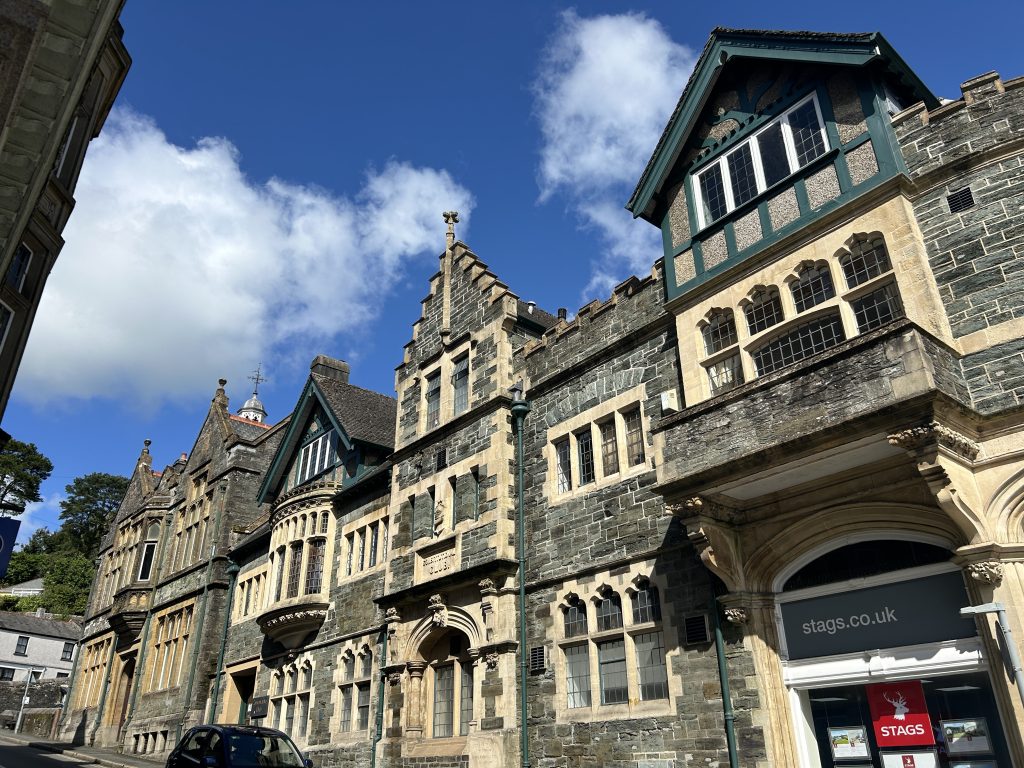
Cream Tea
On our way to Haytor on Dartmoor—one of the day’s highlights—we stop at a café to enjoy a proper Devon cream tea. Although I’m full from my pasty at lunch, I can’t pass up the opportunity to slather jam and clotted cream on a freshly baked scone!
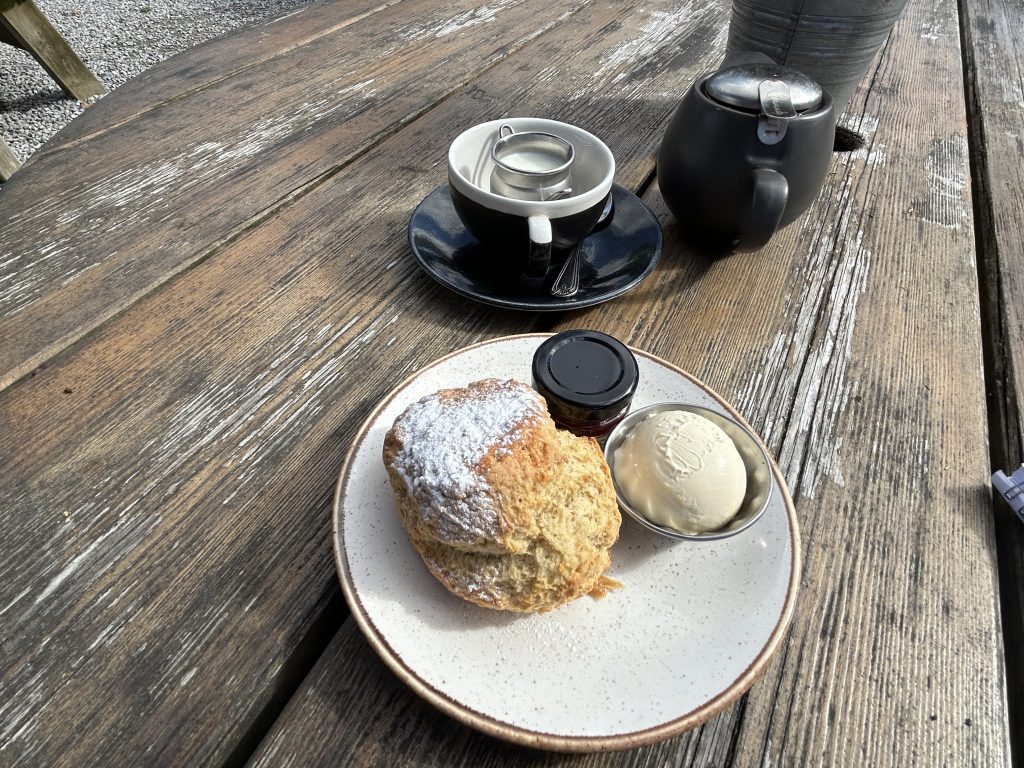
Visit To Haytor on Rabbie’s Small Group Tour
Dartmoor is littered with tors—granite outcroppings that rise above the moor. The most famous, and one of the largest, is Haytor (#16). We are lucky that the weather is glorious for our ascent from the parking lot past grazing wild horses to the base of Haytor.
It is possible to climb to the very top of the grainite tor, but I content myself with enjoying the 360-degree views from the base. It’s pretty dang magnificent.
Here’s a 360-degree video taken from the base of Haytor.
And here are just a few of the many photos I snapped while enjoying Haytor—one of the highlights of the entire Southwest Tour.




Day 4: Devon to Dorset on Rabbie’s Small Group Tour of Southwest England
It’s the final day of our four-day tour of the Southwest. Our mission today is to check out the Dorset coast and then Stonehenge before returning to Bristol.
Lyme Regis on Rabbie’s Small Group Tour
Our first stop is Lyme Regis (#17), known as the pearl of Dorset. Matt drops us at the bottom of the steep main street. I have just an hour and must make a choice. Either I go left to explore the museum or right to walk along the shingled beach to the Cobb, made famous in Jane Austen’s Persuasion. Years ago, I visited the Cobb and so I choose left.
Lyme Regis Museum
The Lyme Regis Museum (#18) is packed full of interesting artifacts and fossils, in keeping with Lyme Regis’s reputation as fossil central. Several displays document the life of the indomitable Mary Anning. Born in 1799, Mary became known internationally for her discoveries of Jurassic marine fossil beds at Lyme Regis. Her findings contributed to changes in scientific thinking about prehistoric life and the history of Earth. Go Mary!
She’s been the subject of novels and films, including Remarkable Creatures by author Tracy Chevalier.
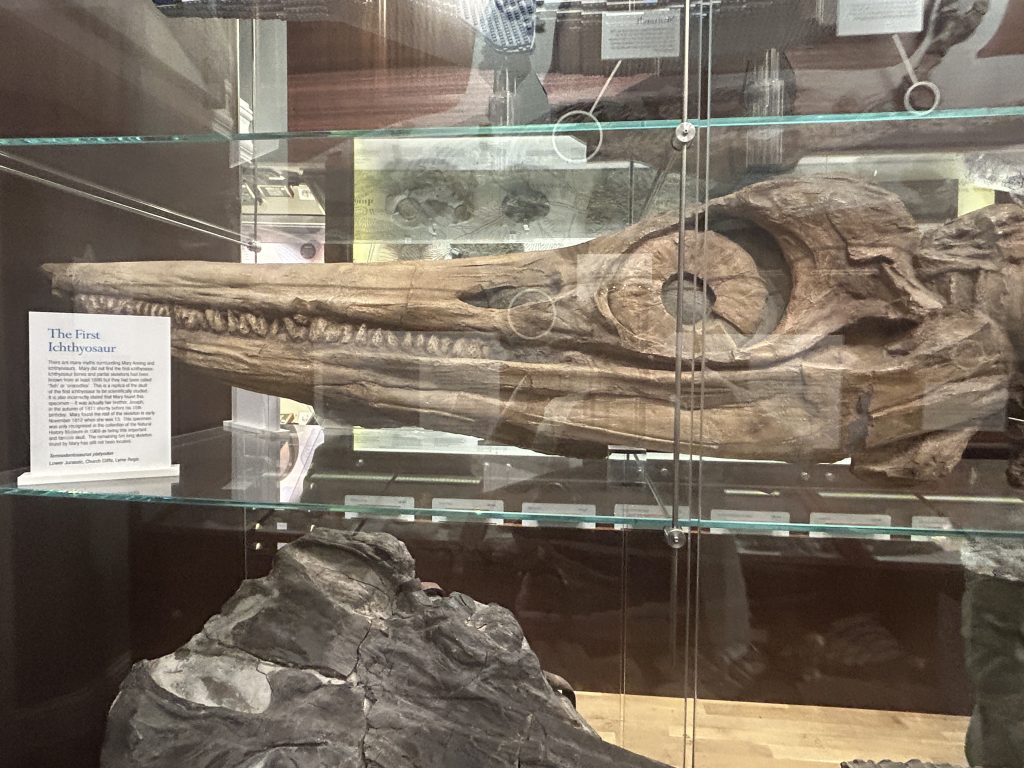
Strolling Lyme Regis
After leaving the museum, I stroll a little way along the beach towards the Cobb. Despite the shops and the crowds, the main street leading down to the water still feels ancient. It’s easy to imagine Anne Elliott from Persuasion strolling along the beachfront.
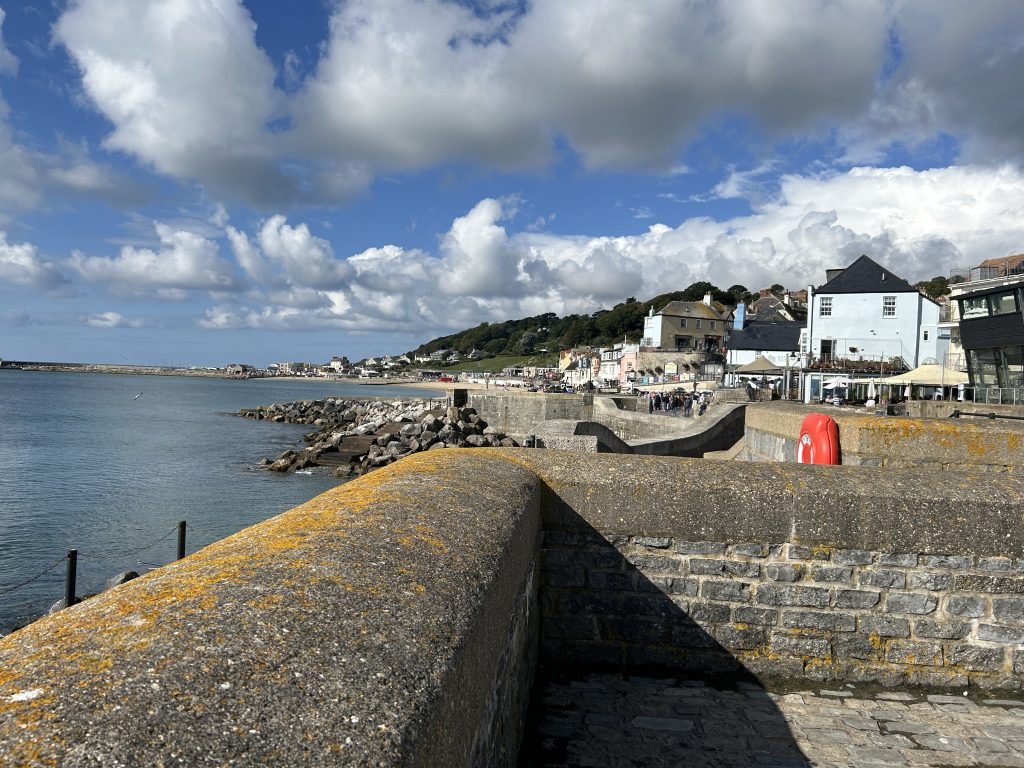
Hiking Down to Durdle Door on Rabbie’s Small Group Tour
Another hour on the road takes us to Durdle Door (#19) in Dorset. Last night, Matt asked each of us to supply him with the titles of three or four of our favorite songs. During the drive, he plays all our songs. It’s an eclectic mix including some smooth and jazzy Brazilian music, When I’m 64 by The Beatles, a track by Taylor Swift, various country and rock cuts, and my own contributions—Carole King, Simon & Garfunkel, and Rod Stewart.
At Durdle Door, I’m faced with a very steep walk down and back. My poor knee is not happy, but I ignore the pain and set off. Unfortunately, Durdle Door is not visible from the car park so in order to get some photos and enjoy the stunning views, I need to walk.
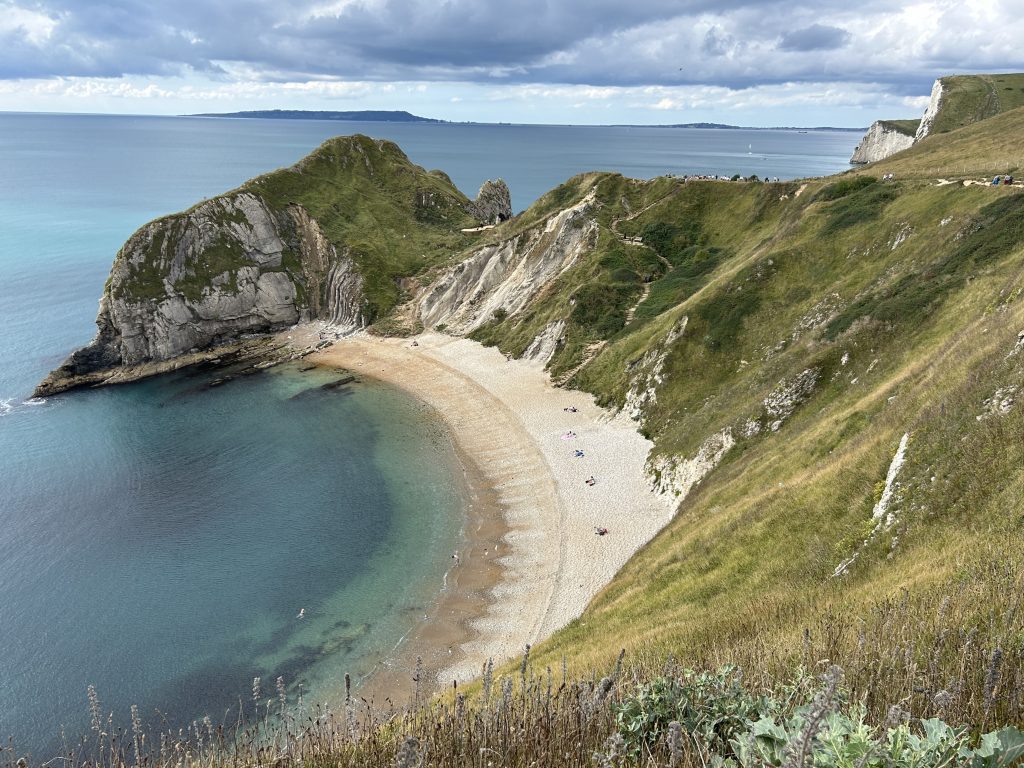
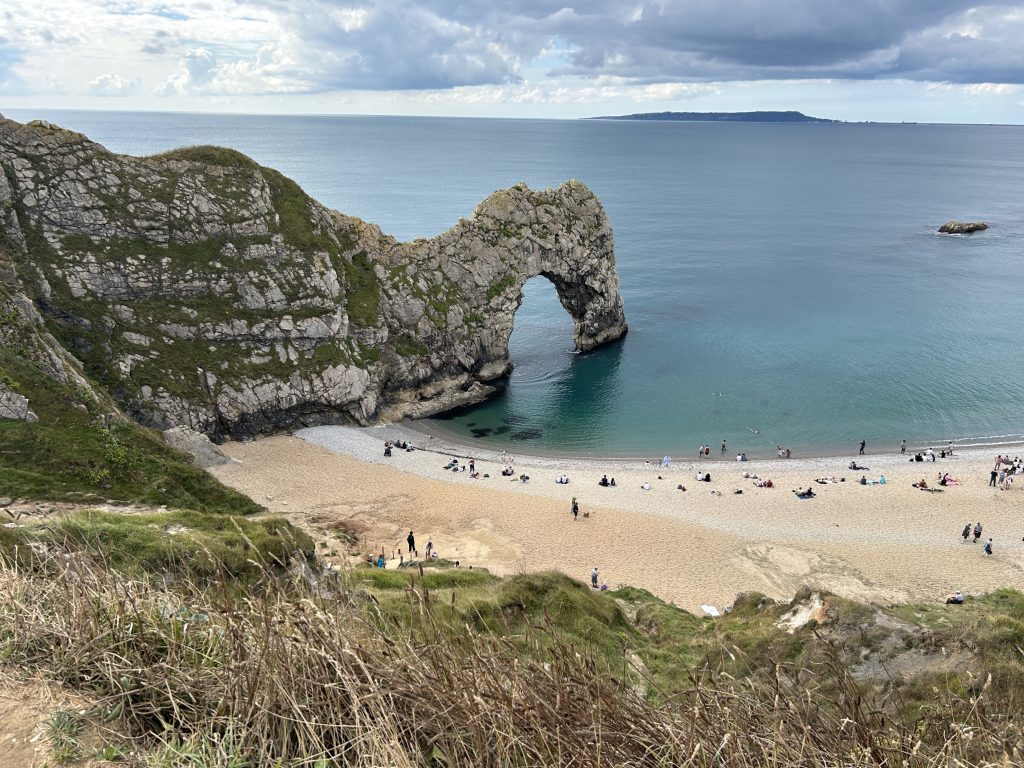
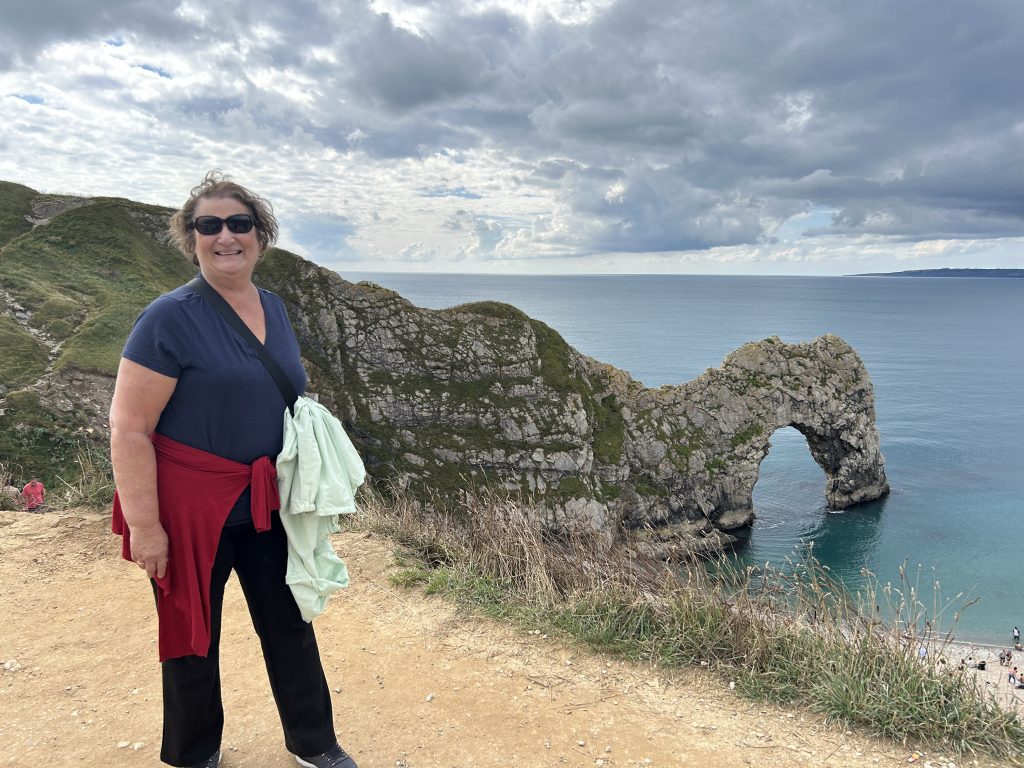
Lulworth on Rabbie’s Small Group Tour
The little village of Lulworth (#20) is an easy downhill walk from Durdle Door. We drive there, park, and walk down the single street to the cove. There really isn’t a whole lot to do except walk down to the cove, look at the cove, buy lunch, eat it on the beach while looing the cove, walk back from the cove, and then buy a fridge magnet depicting Durdle Door.
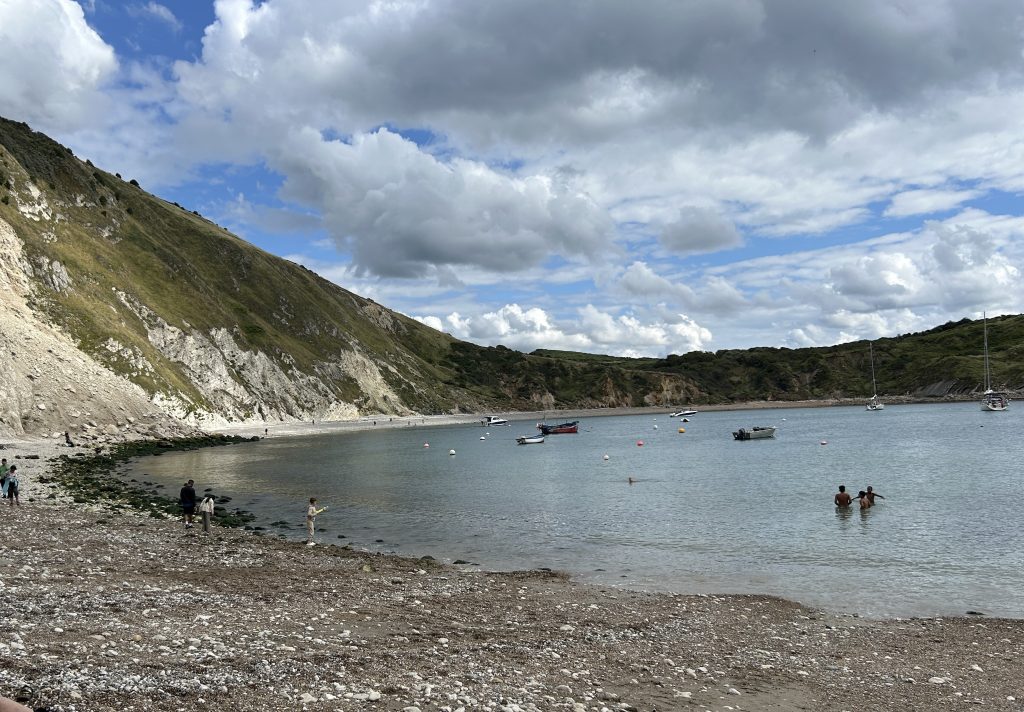
Stonehenge on Rabbie’s Small Group Tour
Our final stop of the day—and of the four-day tour—is Stonehenge (#21), where we will be five of the one million visitors who check out this massive stone circle every year. I’ve visited Stonehenge a few times over the years and seen quite the evolution.
Back in the 1970s, I was able to walk right up to the stones, touch them and pose on them. Such free access was curtailed in the 1990s because of damage being caused to the stones. When I visited in 2001, I bought my tickets at a pokey kiosk next to the parking lot, walked a fair distance to the stones, walked around the stones, walked back, and that was about it. I don’t even think there was a gift shop.
Well, welcome to 2024! The visitor experience has been transformed into a slickly managed sequence of carefully orchestrated activities. After getting tickets (Matt takes care of this for us), we are fitted with paper bracelets that include a QR Code. I scan the code and download the audio guide, which provides a worthwhile commentary of the Stonehenge Experience.
Shuttling to Stonehenge
I board a shuttle bus for the five-minute ride to the stone circle and begin the circumnavigation to view it from every angle. Although I’ve seen Stonehenge before, I still find it impressive. Who built it? Why? How?
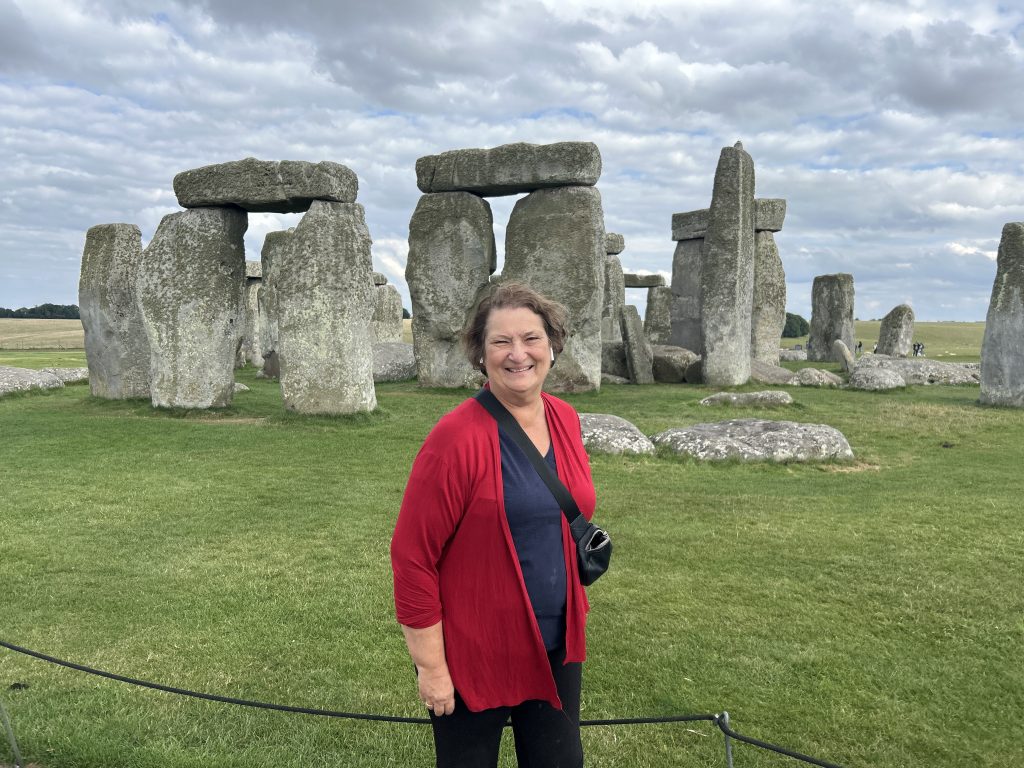
I snap plenty of pictures. Even though the site is full of visitors, it doesn’t feel overwhelming, perhaps because the stone circle itself is empty. It’s easy to get atmospheric shots that evoke the ancient past without including other visitors.
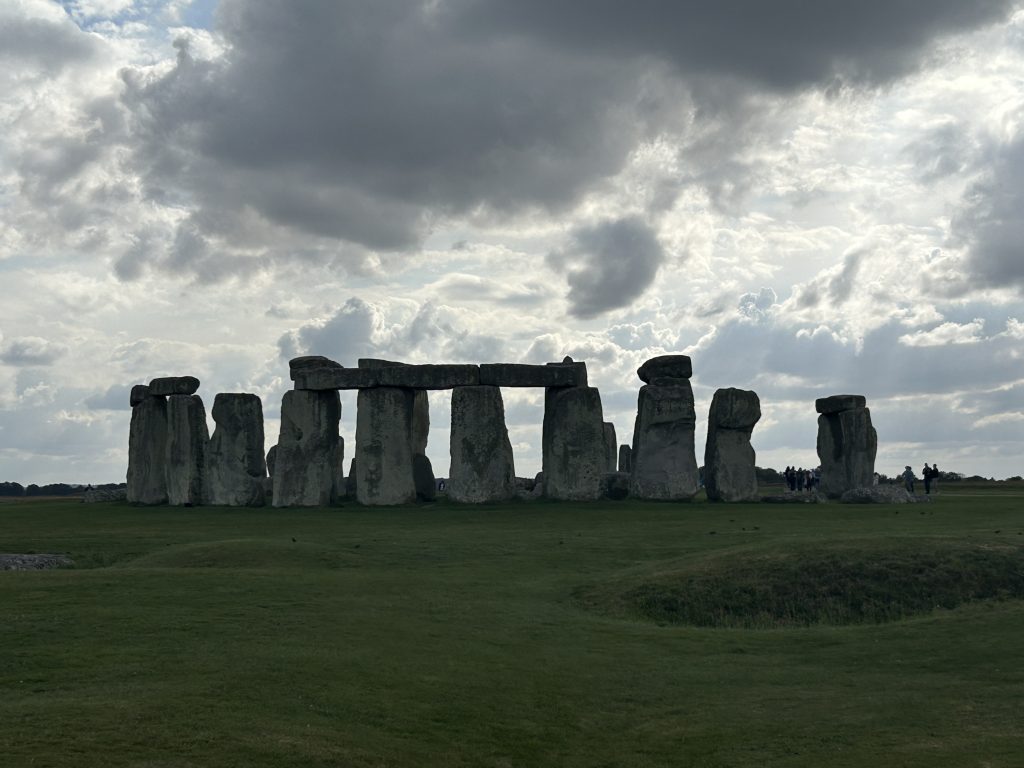
After getting my Stonehenge fix to last me another decade or two, I take the shuttle bus back to the stylish Visitor Centre. The small exhibition is high-tech and interesting and includes re-creations of the types of houses that the people who built Stonehenge may have lived in.
And finally, I enter the giftshop—the largest I’ve seen on this trip, and that’s saying something! It’s remarkable how many Stonehenge-themed items are on display, from sweatshirts to water bottles to socks and a lot, lot more. I resist buying yet another fridge magnet.
Onwards Back to Bristol
We’re back on the bus for the last time. The trip west to Bristol (#22) takes longer than expected thanks to traffic but I don’t mind. I’m enjoying looking out the window and thinking about the past four days.
For me, the highlights of the tour were the opportunities to walk in the countryside at sites such as Tintagel, Haytor, and Durdle Door, and visits to museums like the Tate St. Ives and the Lyme Regis Museum. I could have skipped Lulworth, Land’s End, and Jamaica Inn in favor of more opportunities to be in the countryside. However, a guided tour must make choices and people do need to be fed and have access to toilets.
Conclusion
Thank you to Rabbie’s Tours for a memorable four days. I recommend the tour for travelers who don’t want to drive and want to pack in as many sites as possible in a short period without sacrificing some memorable experiences. Kudos to our guide, Matt, for his patience and good humor.
Have you taken a Rabbie’s Tour? Share your comments and suggestions in the comments below.
